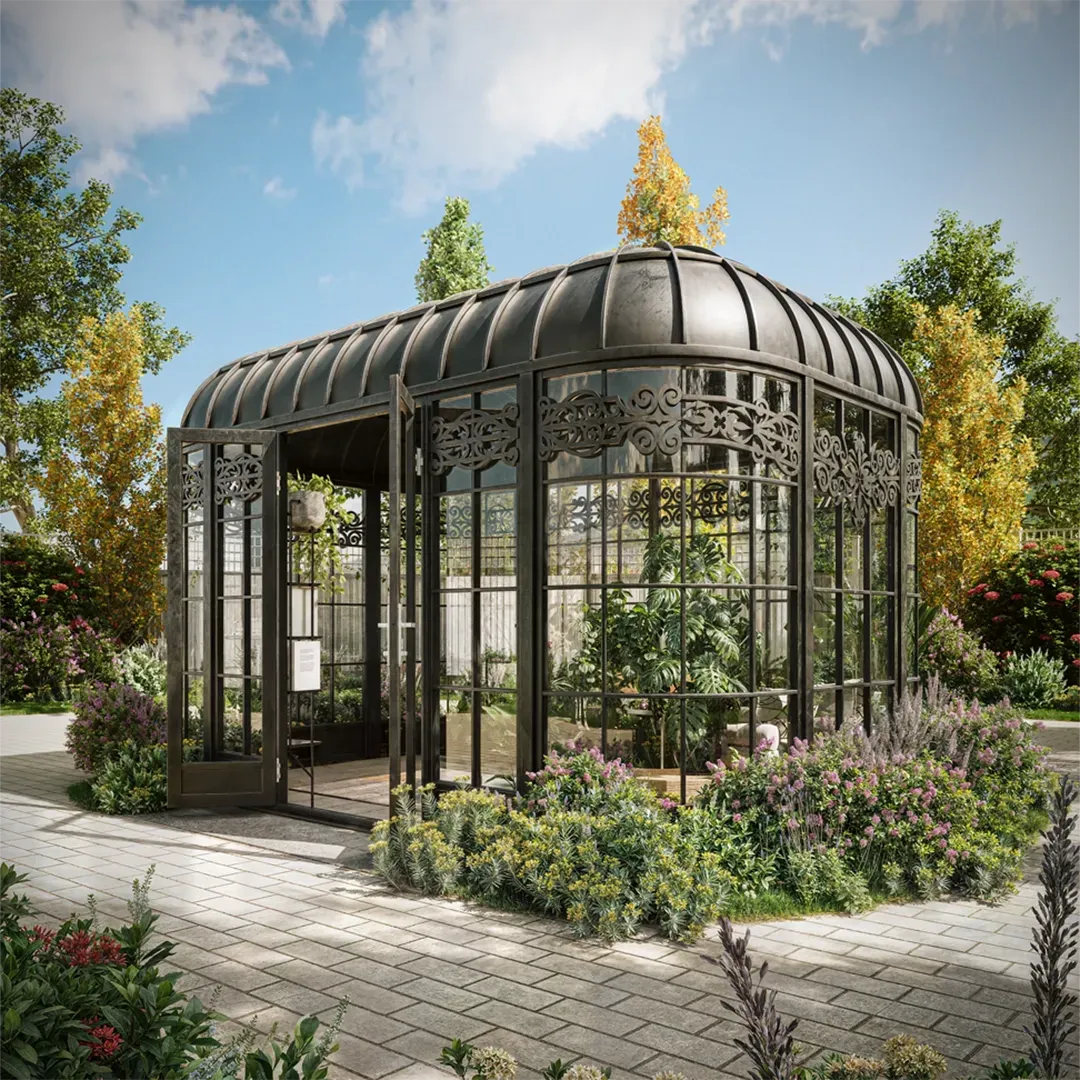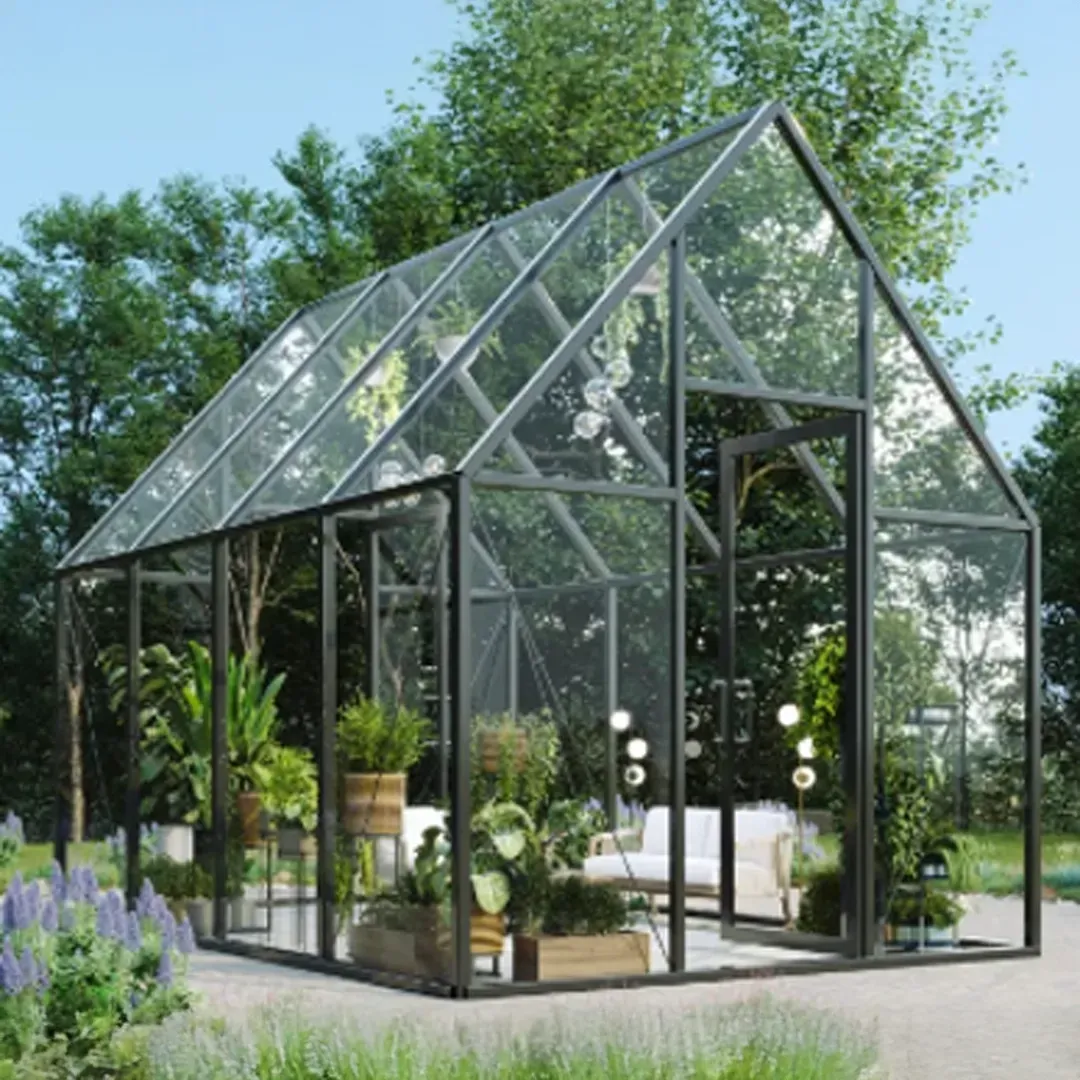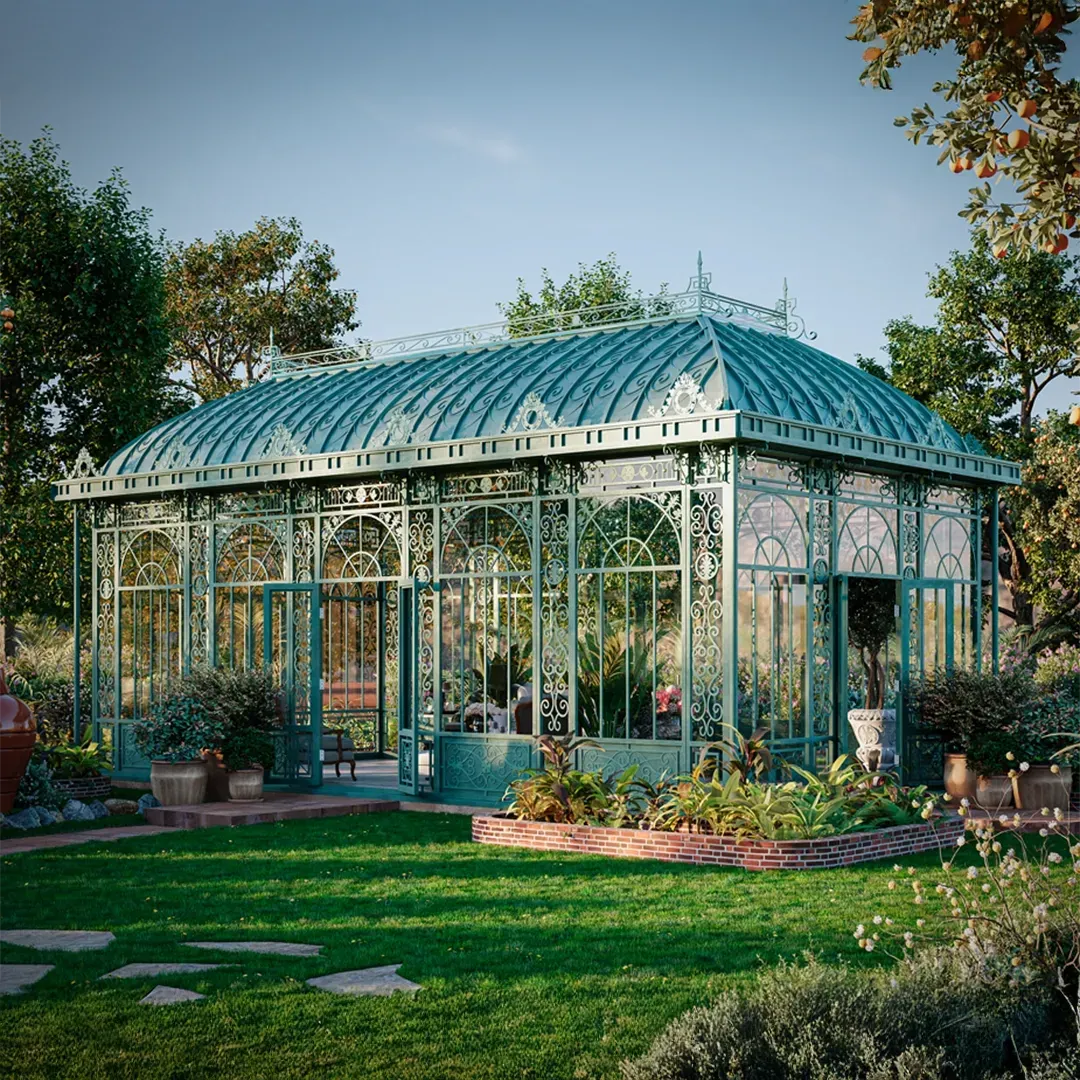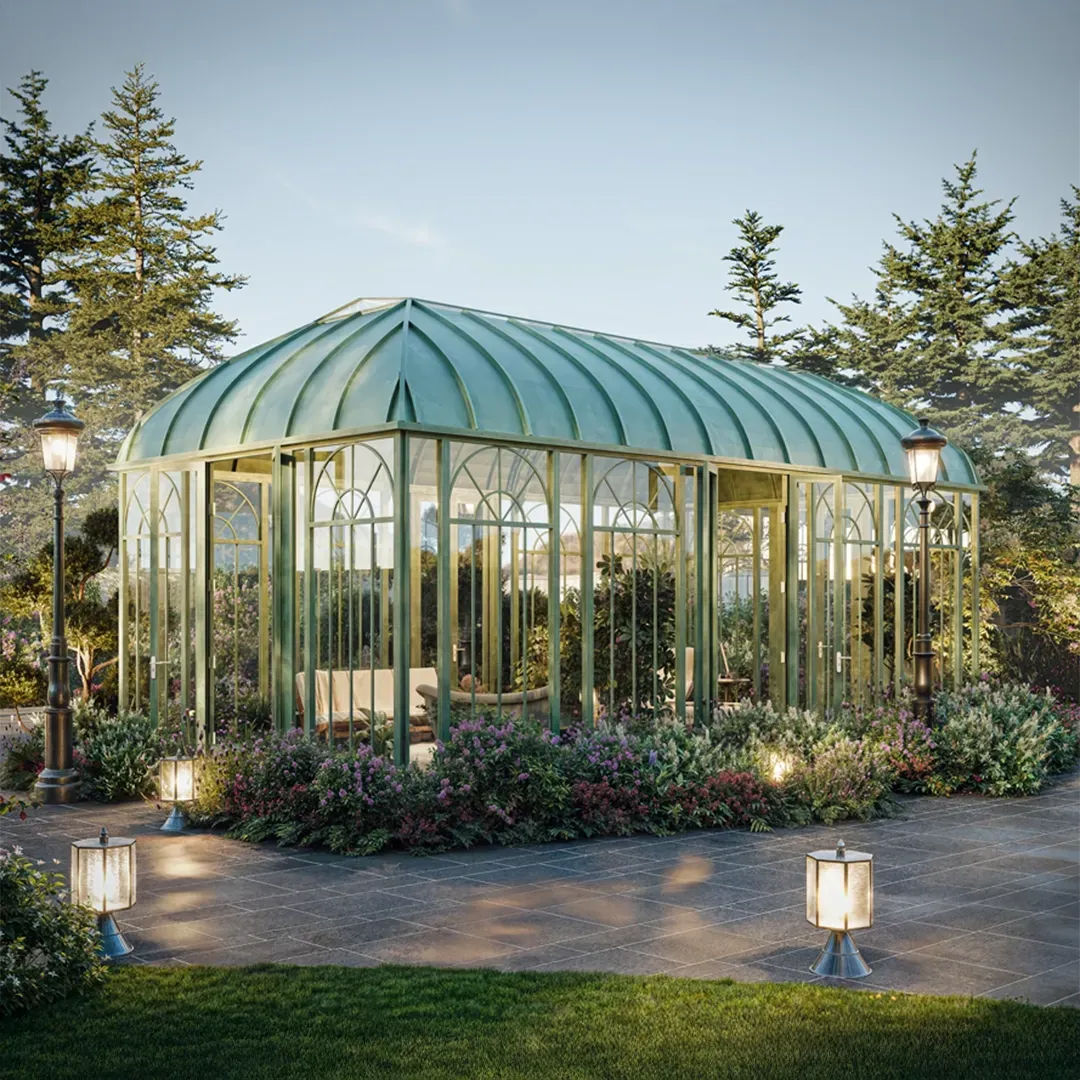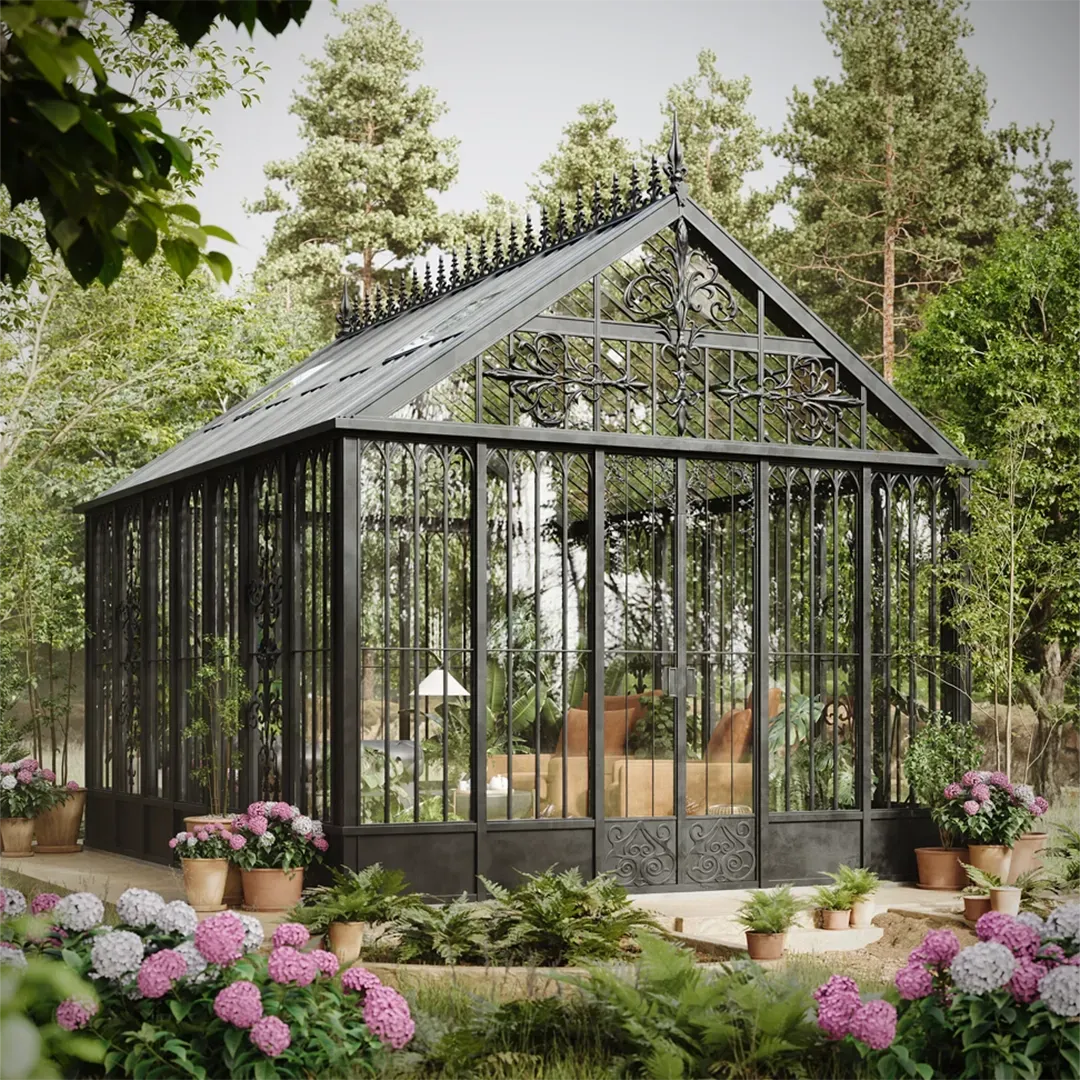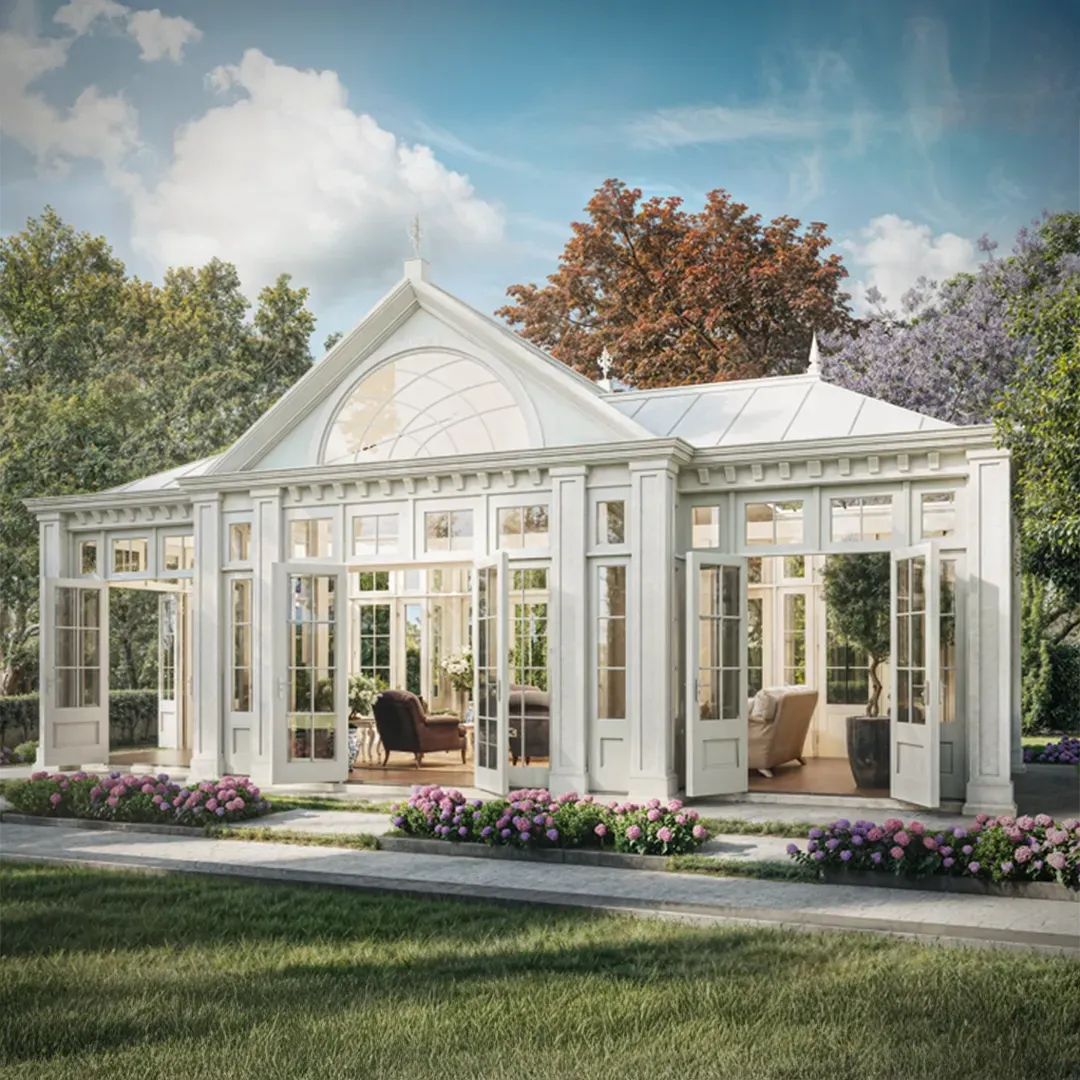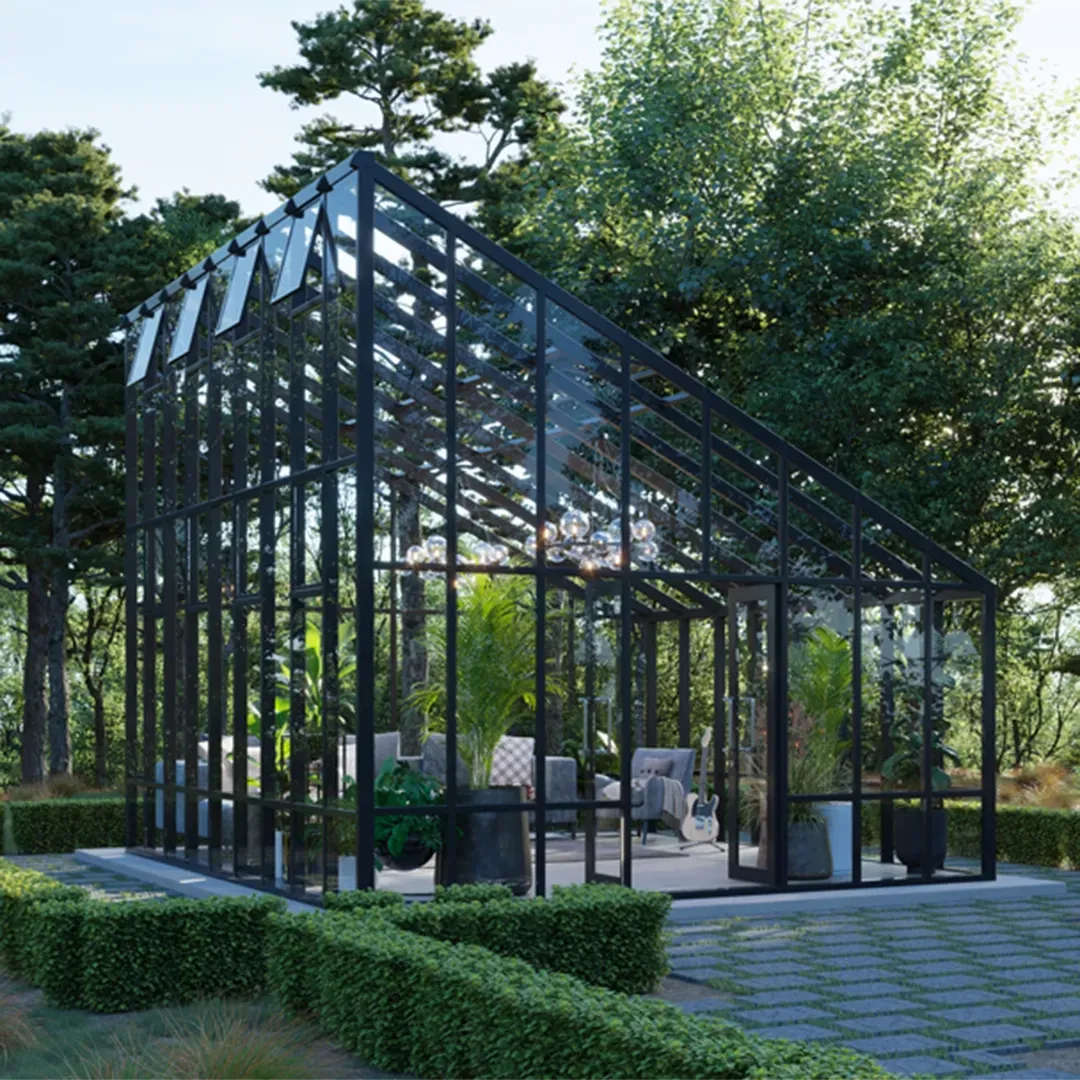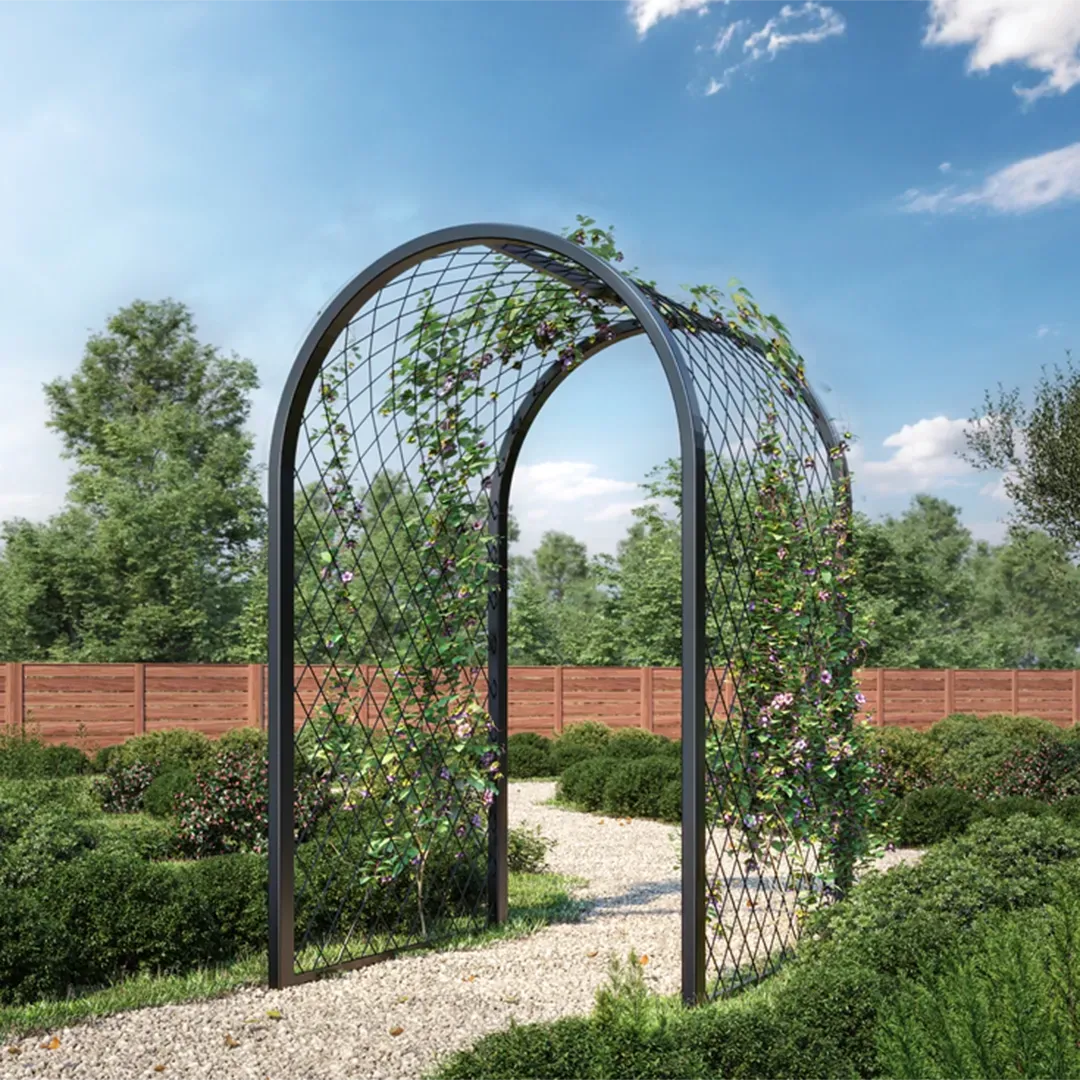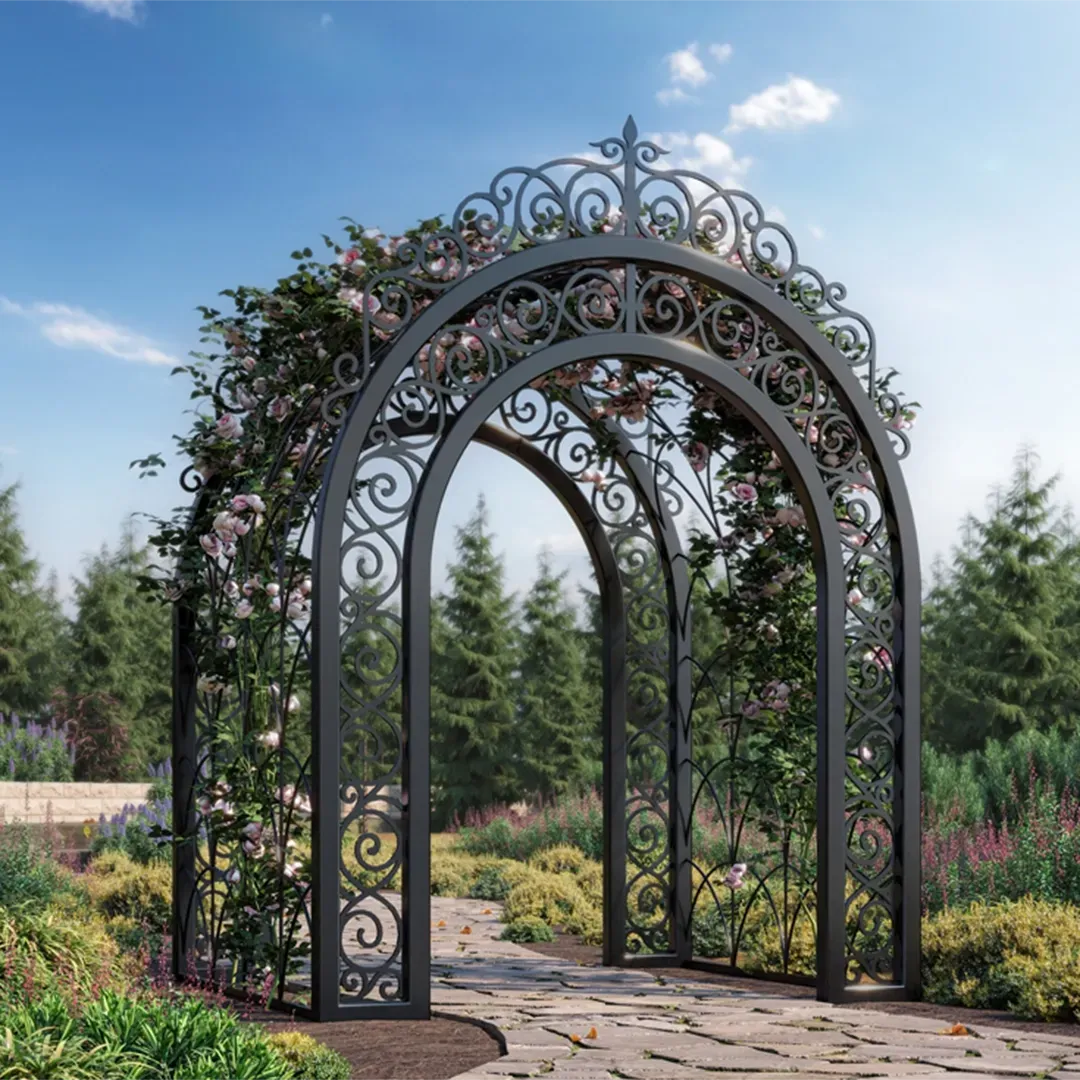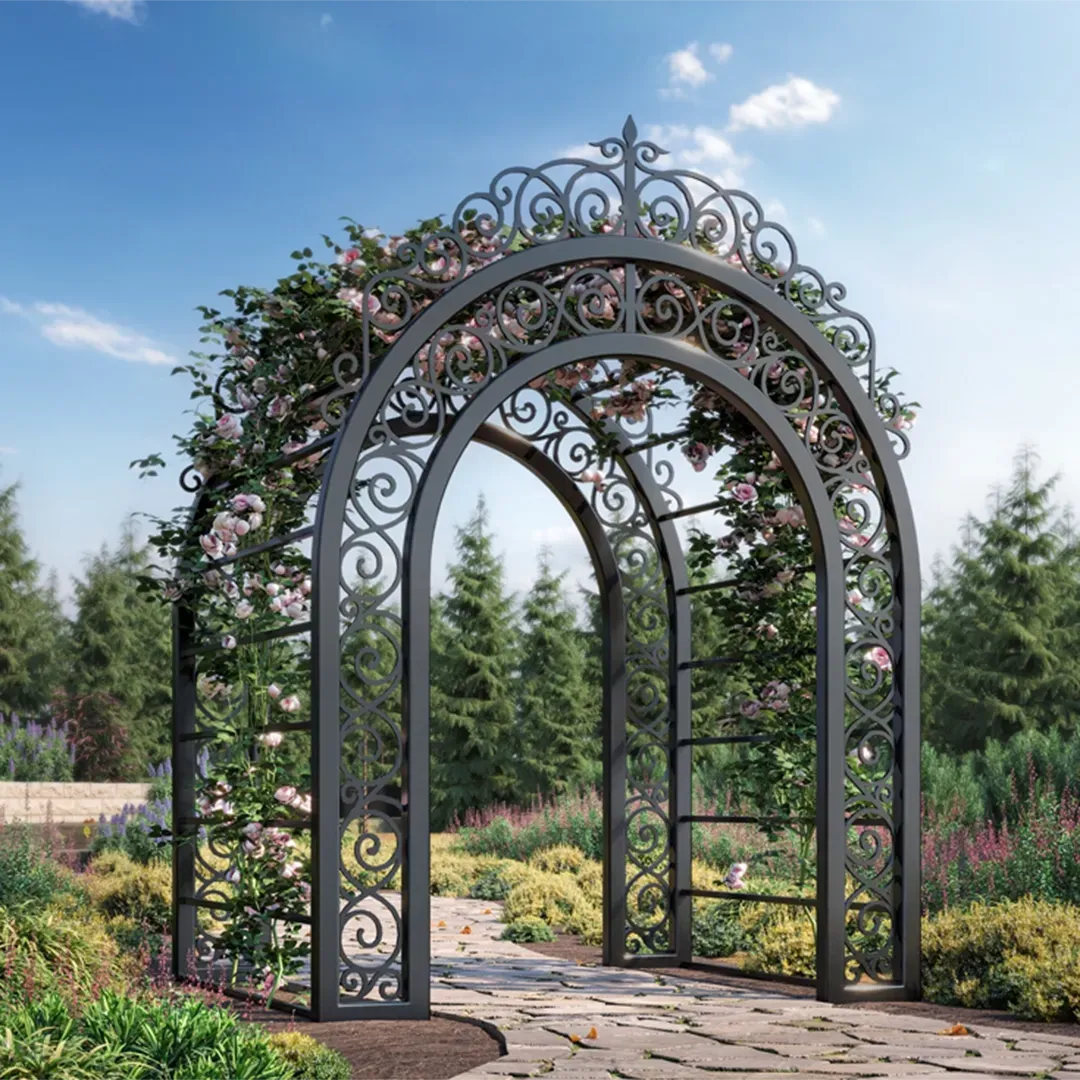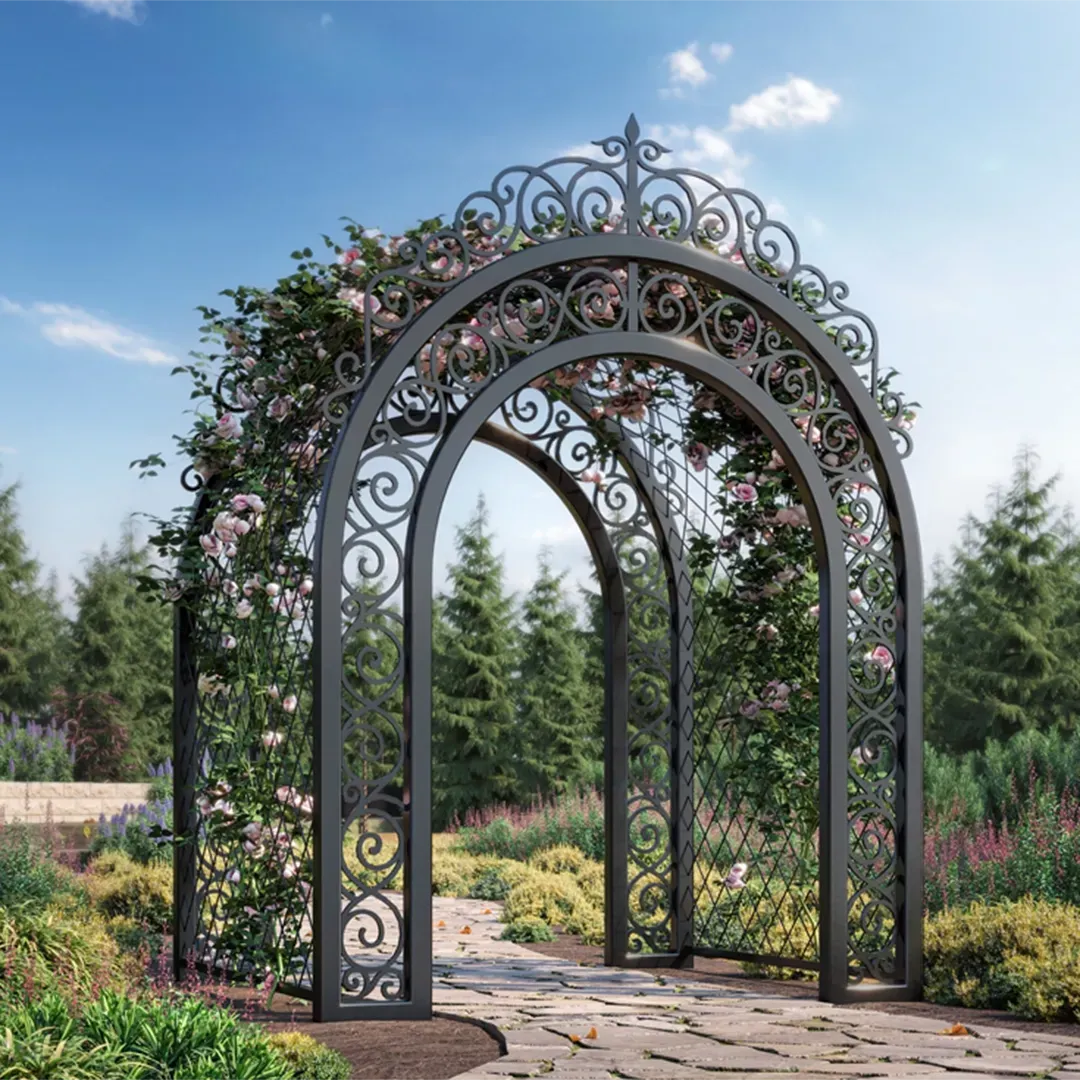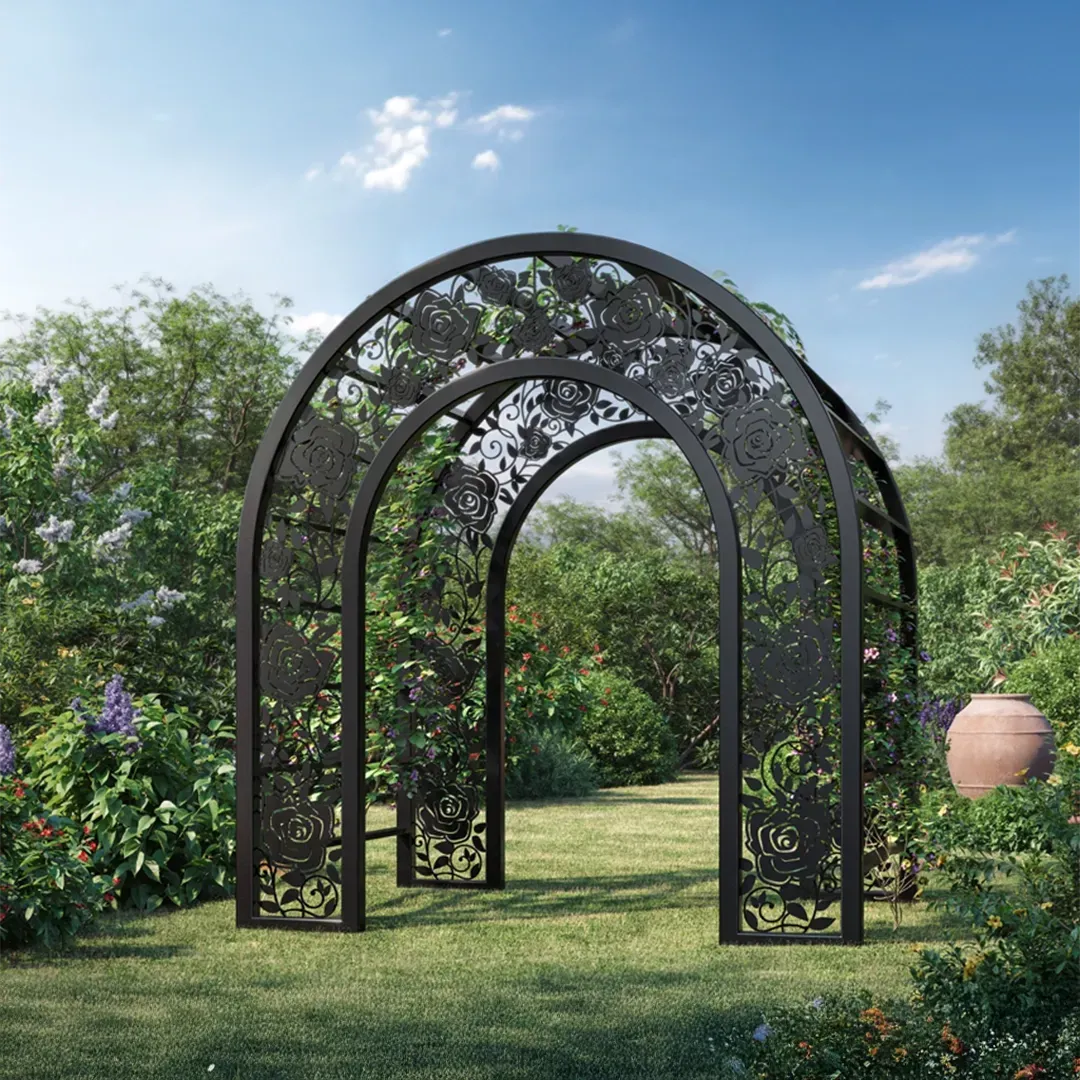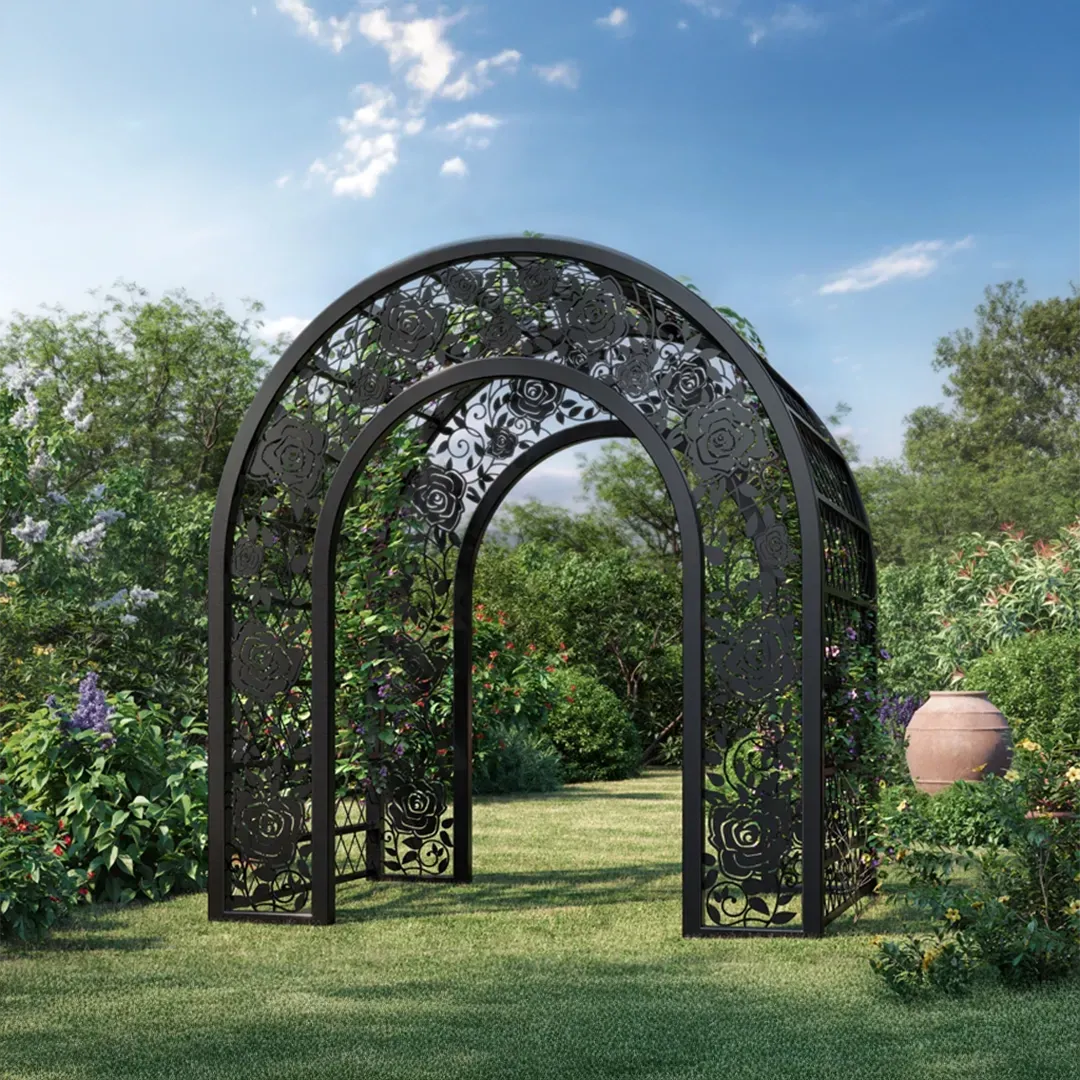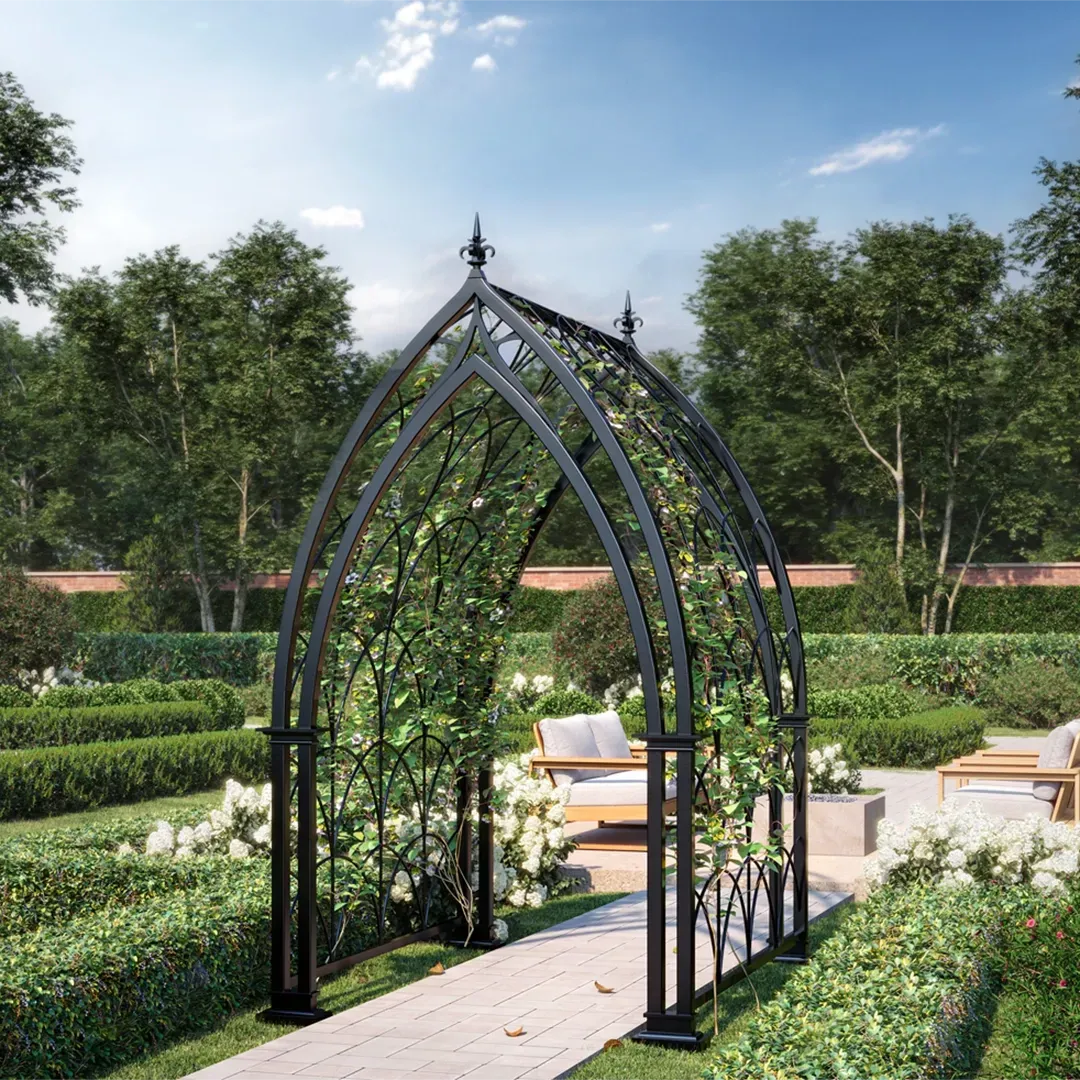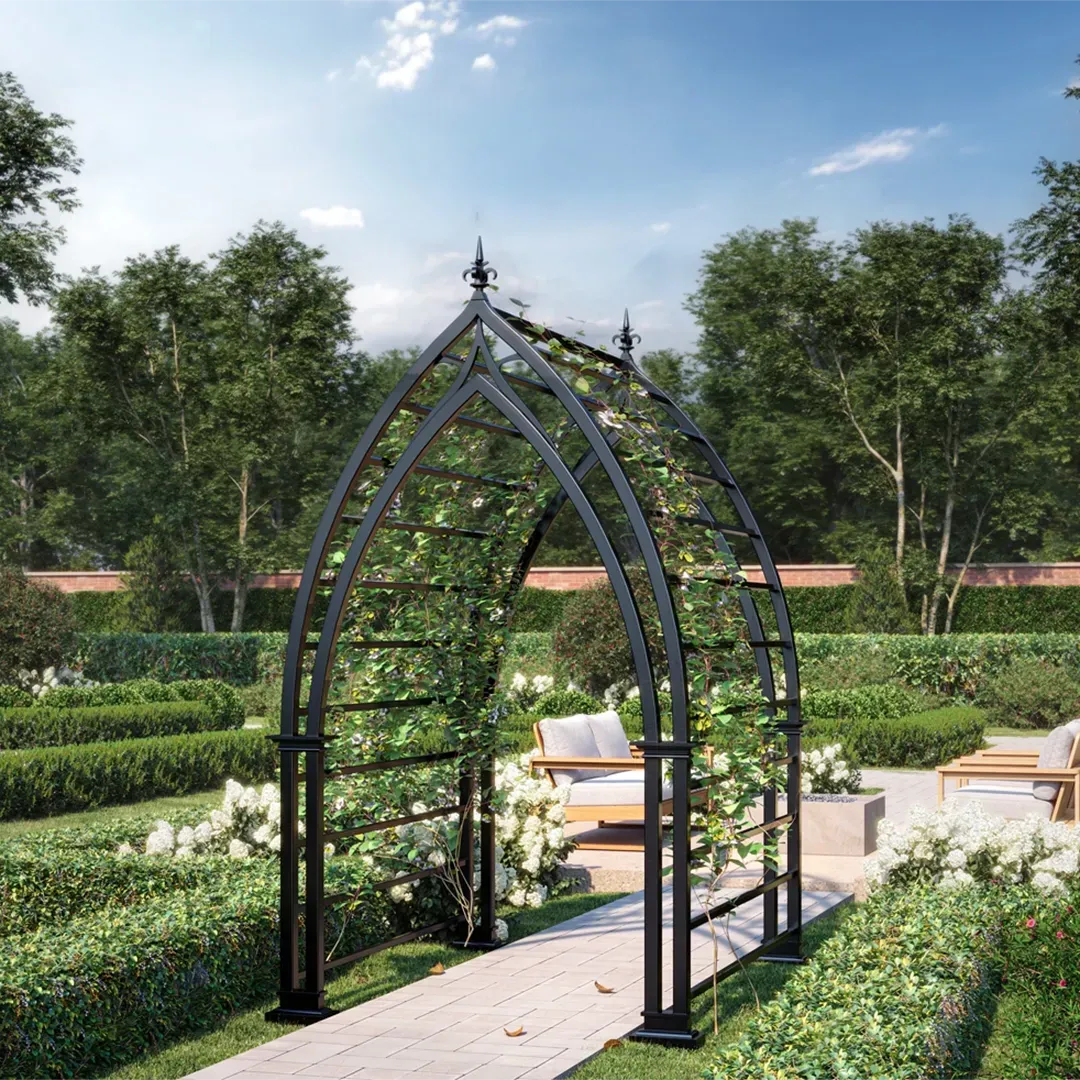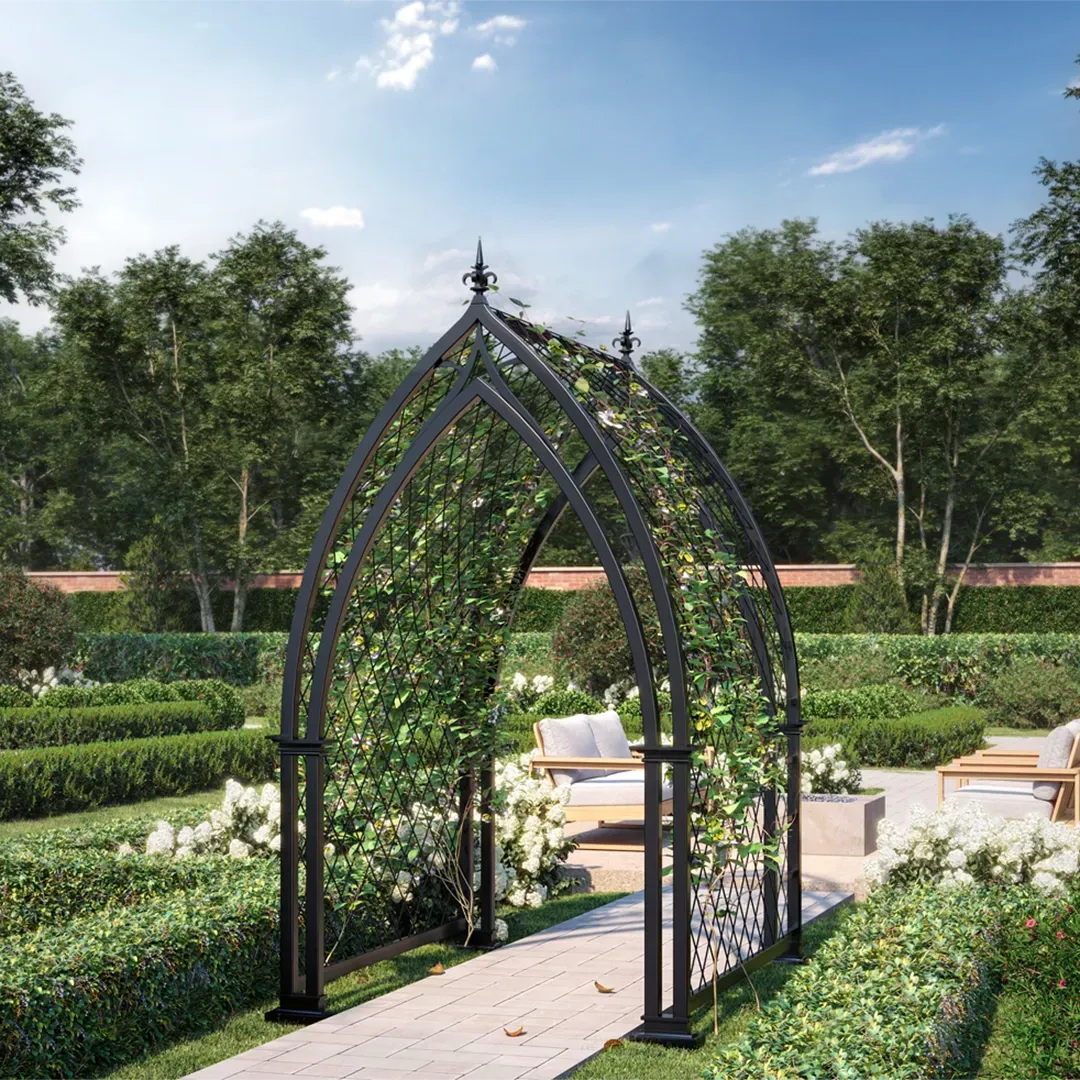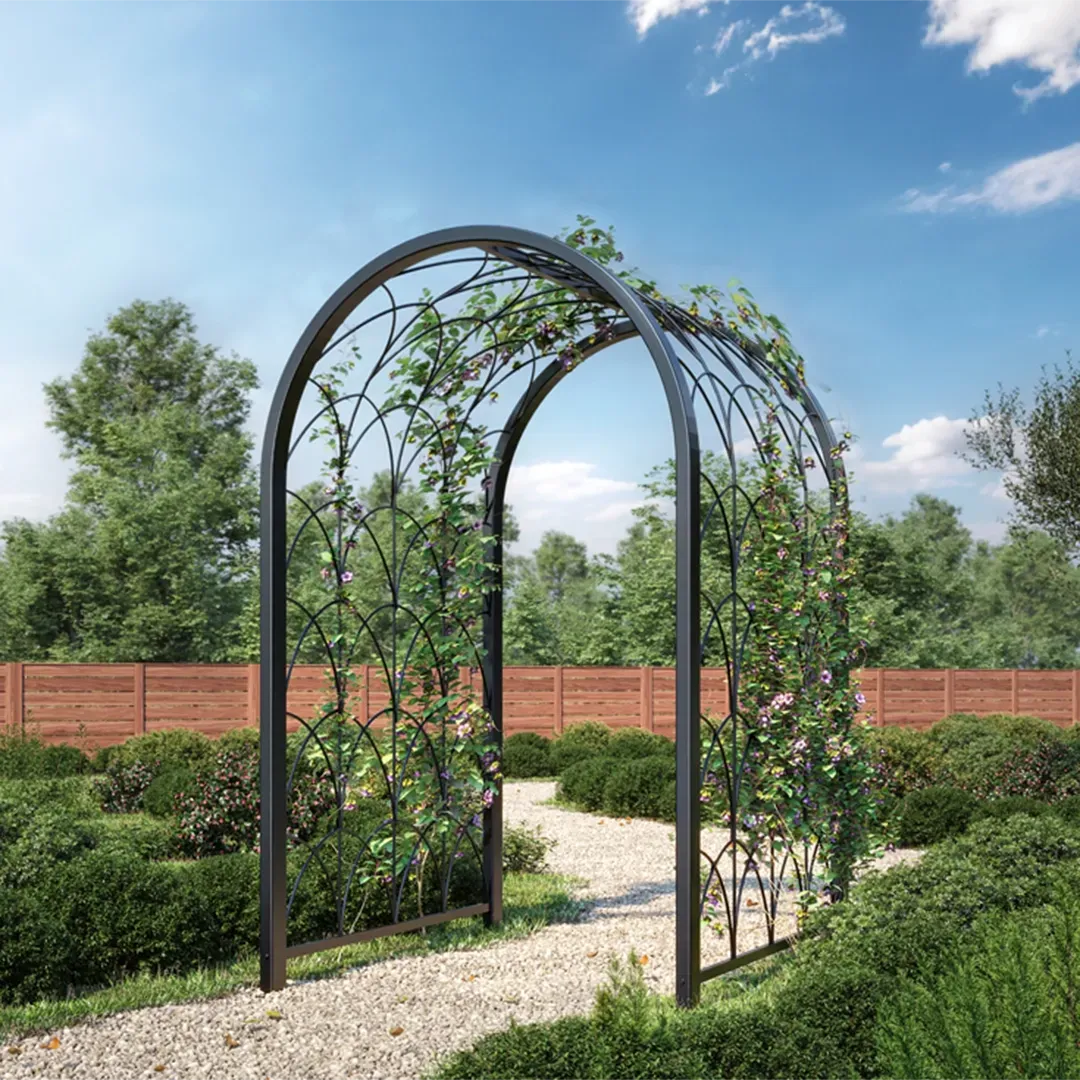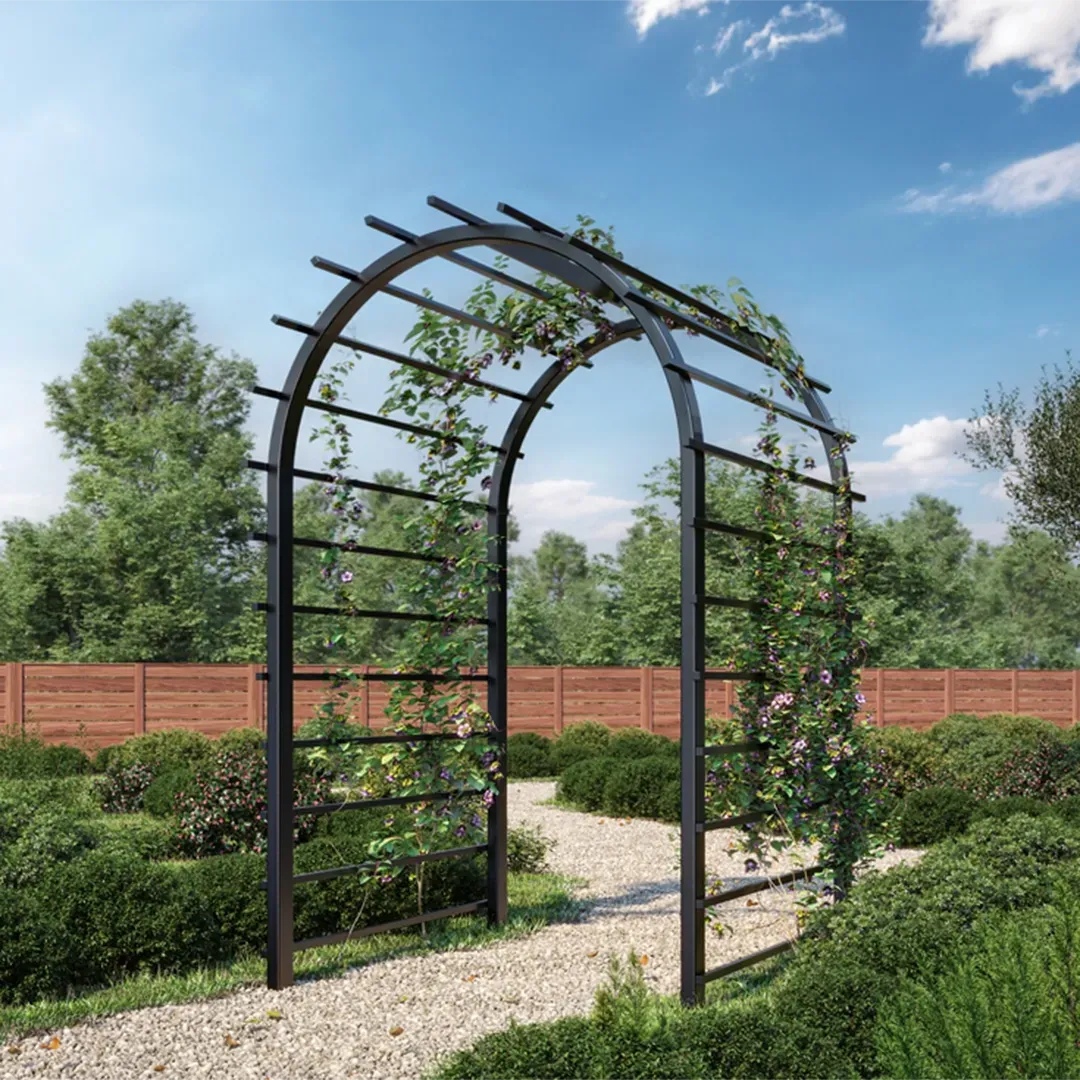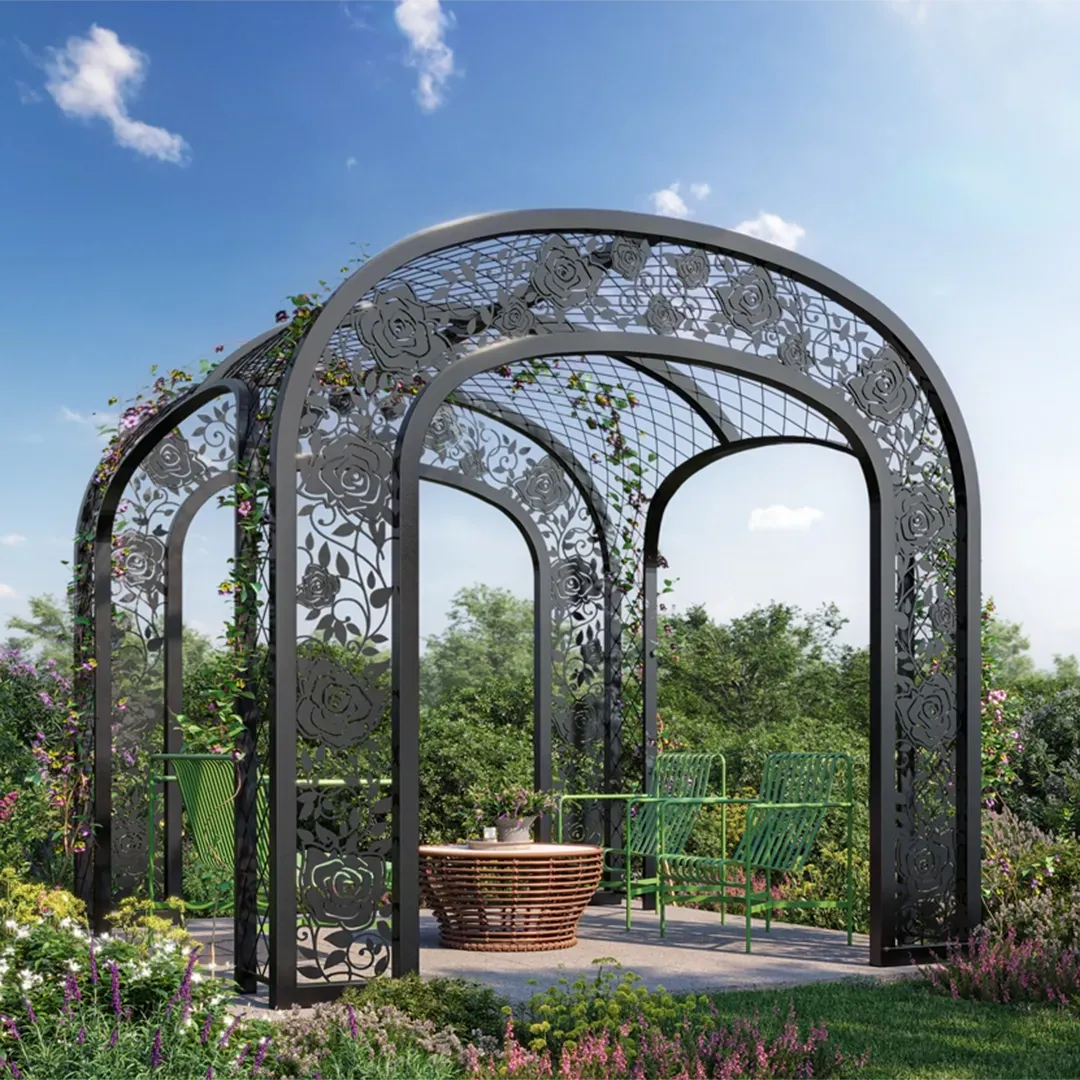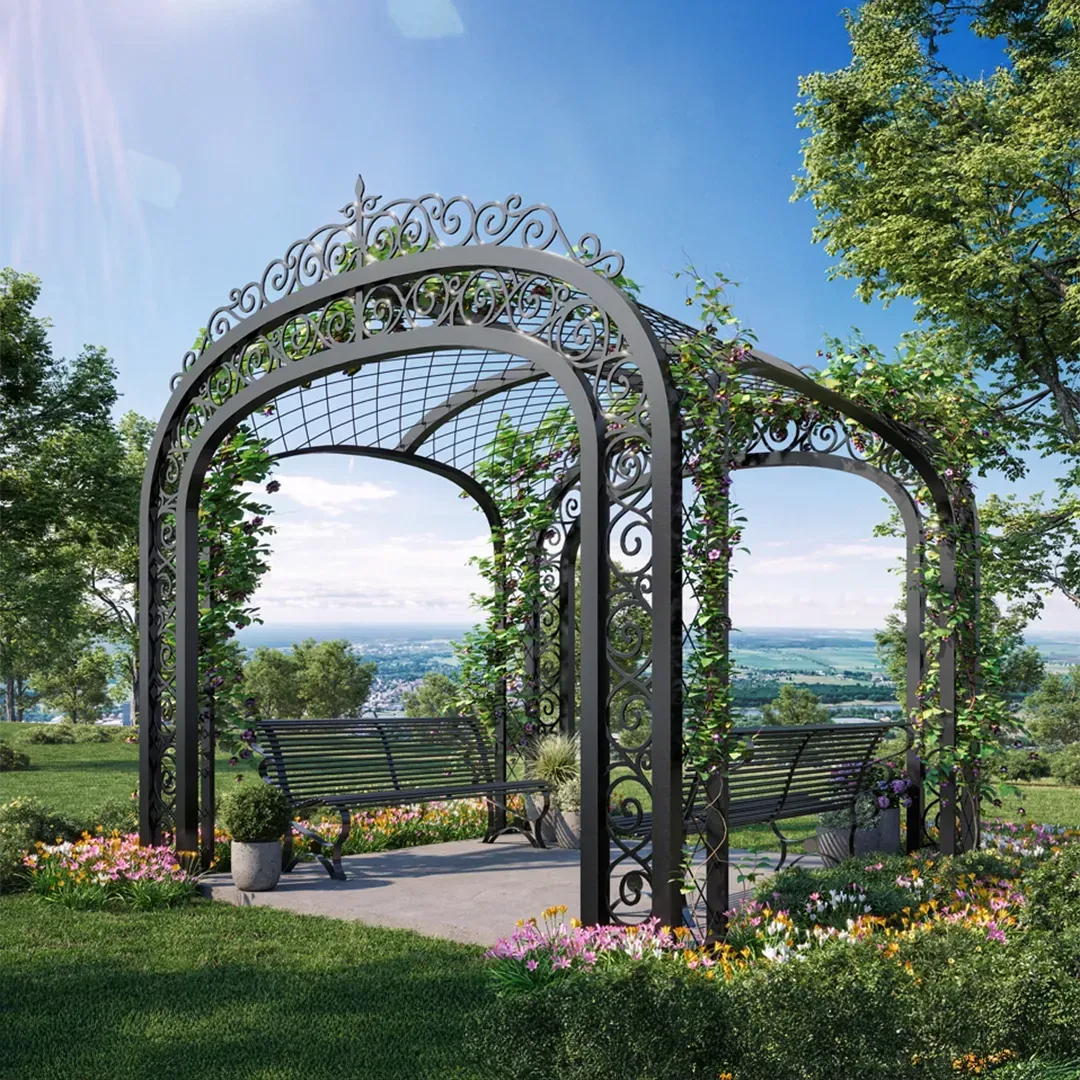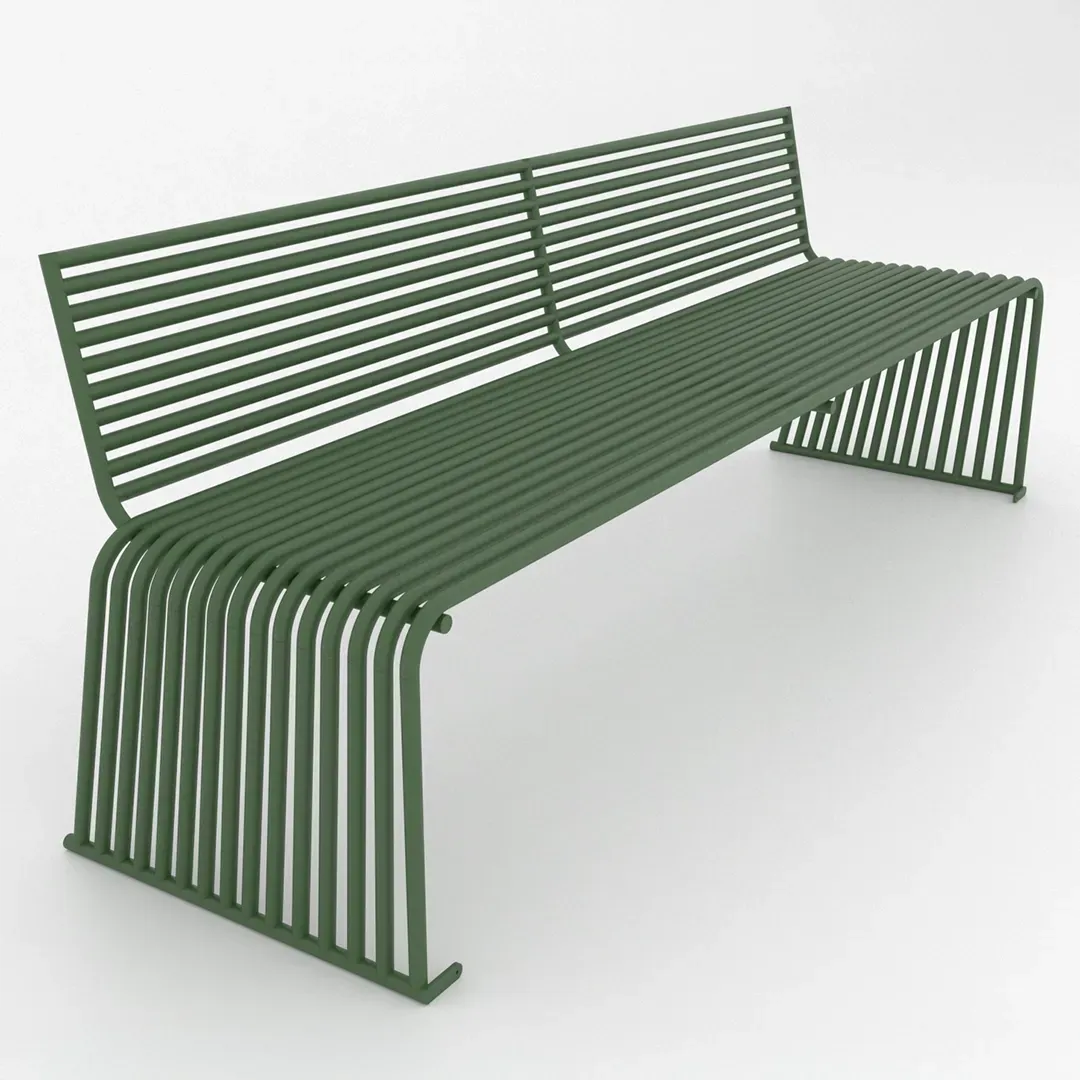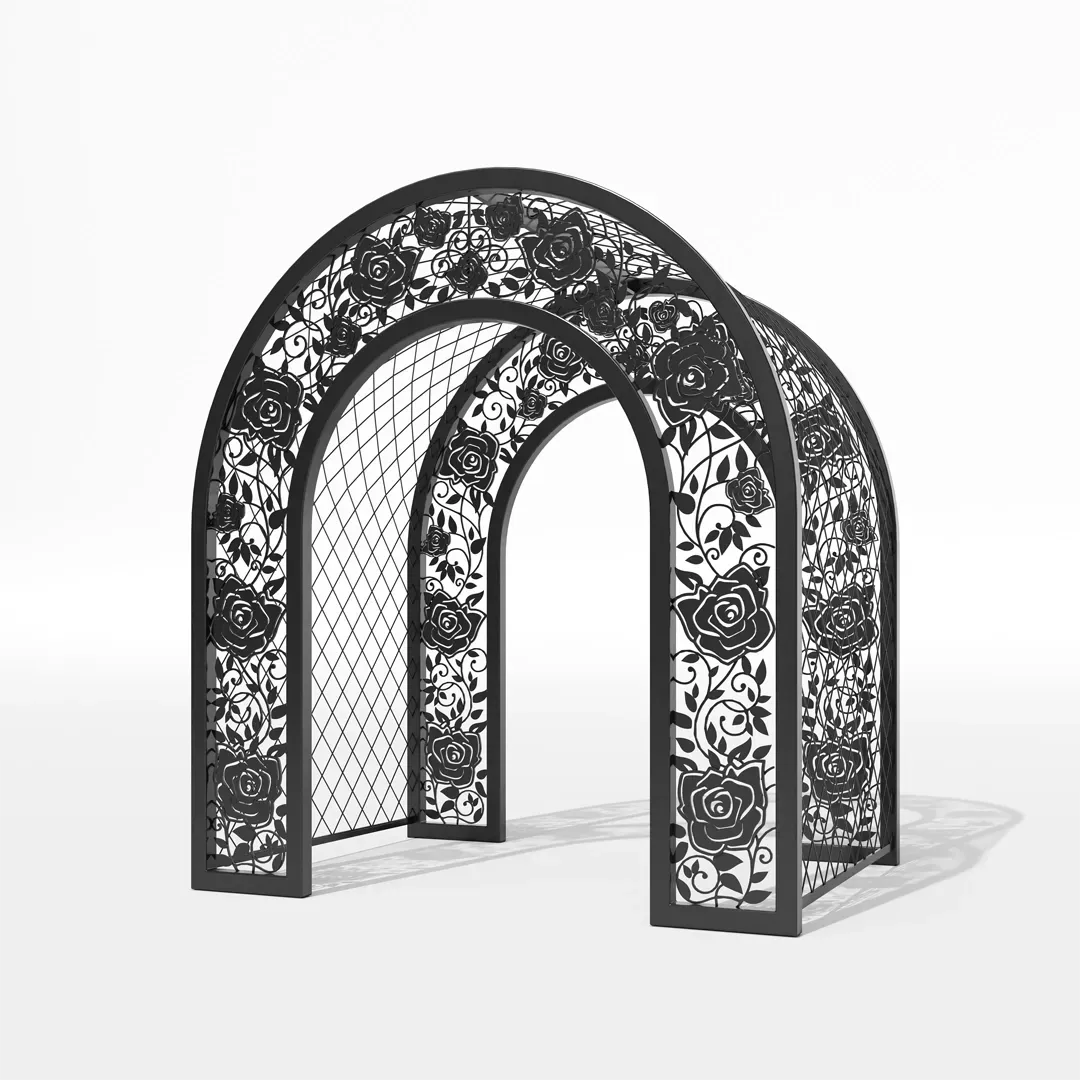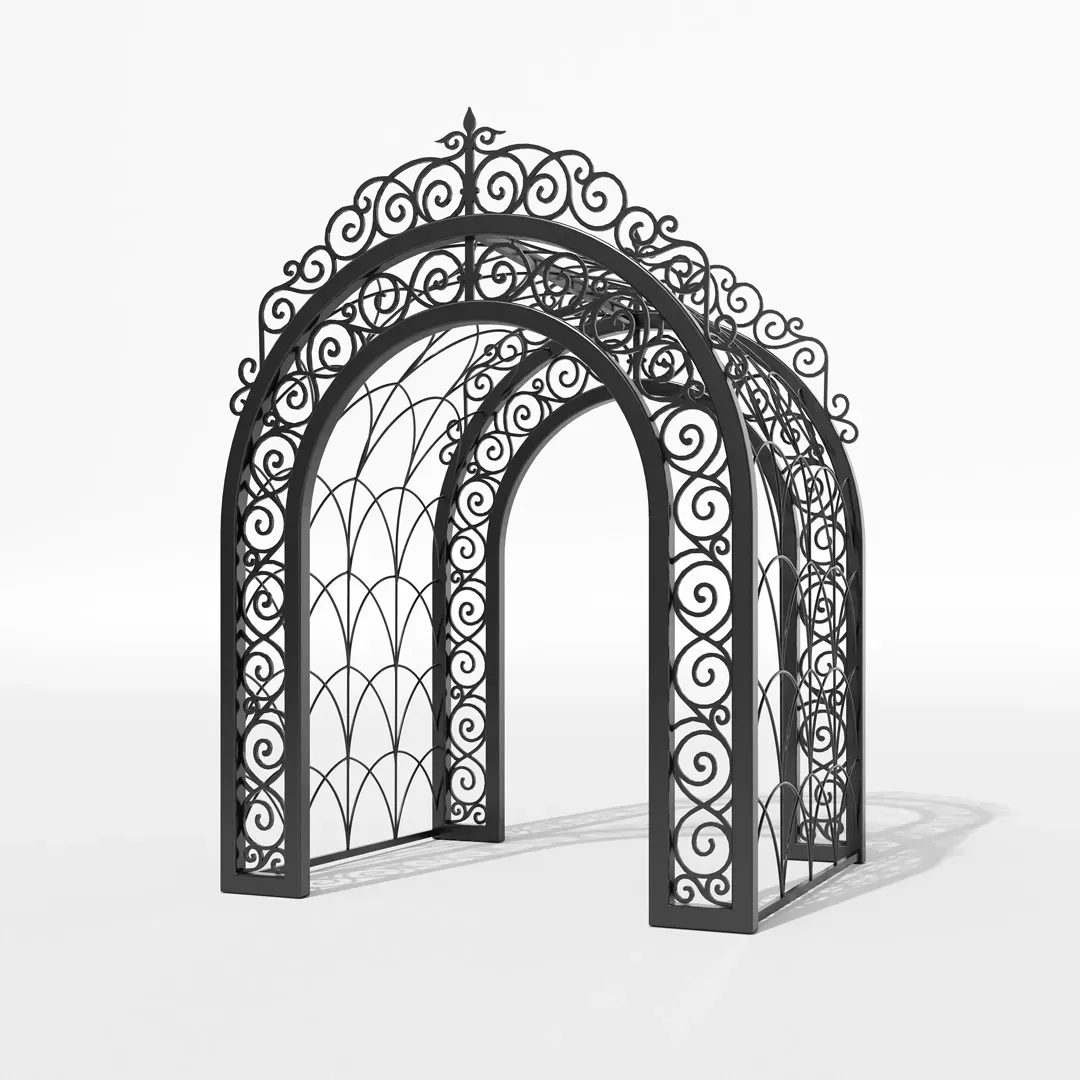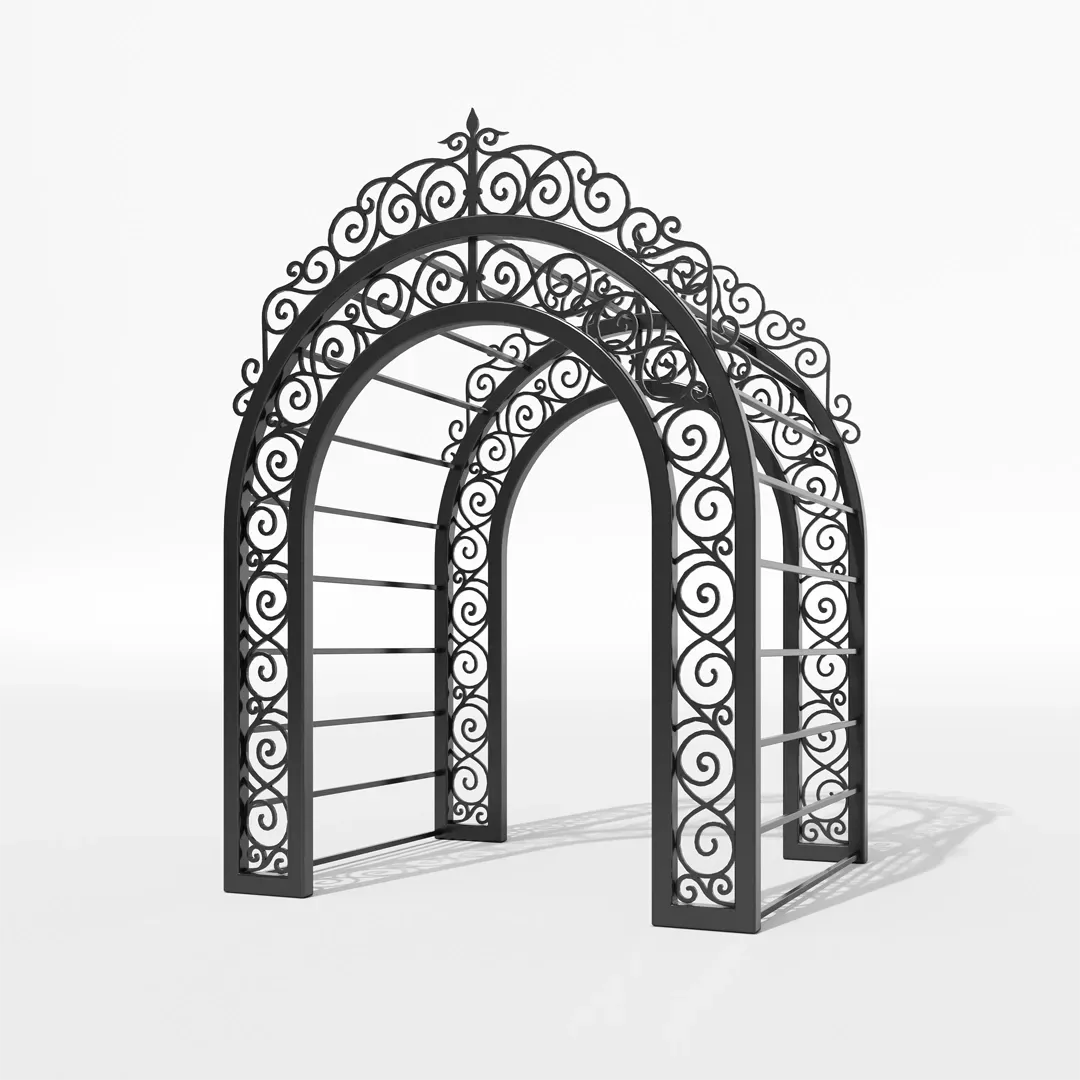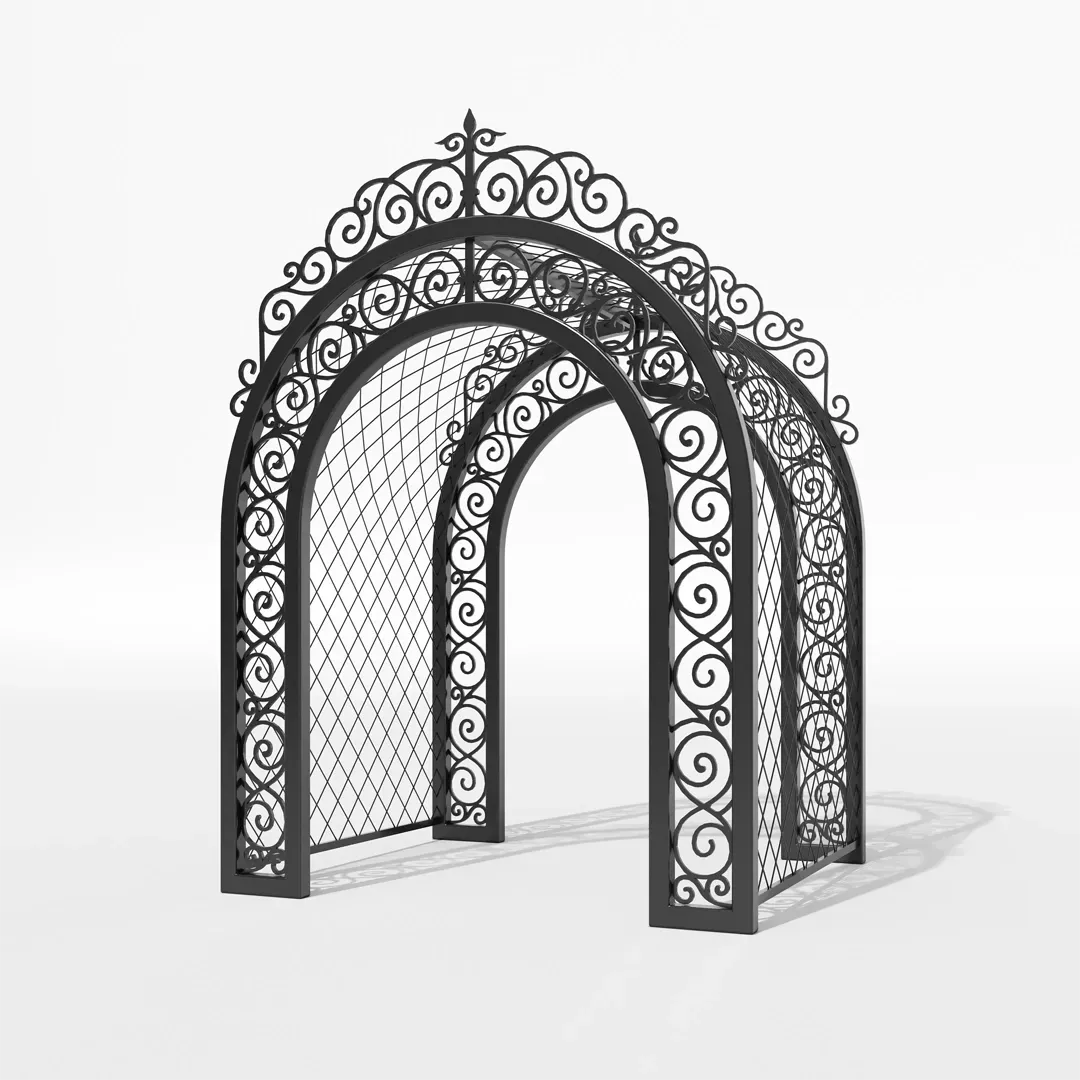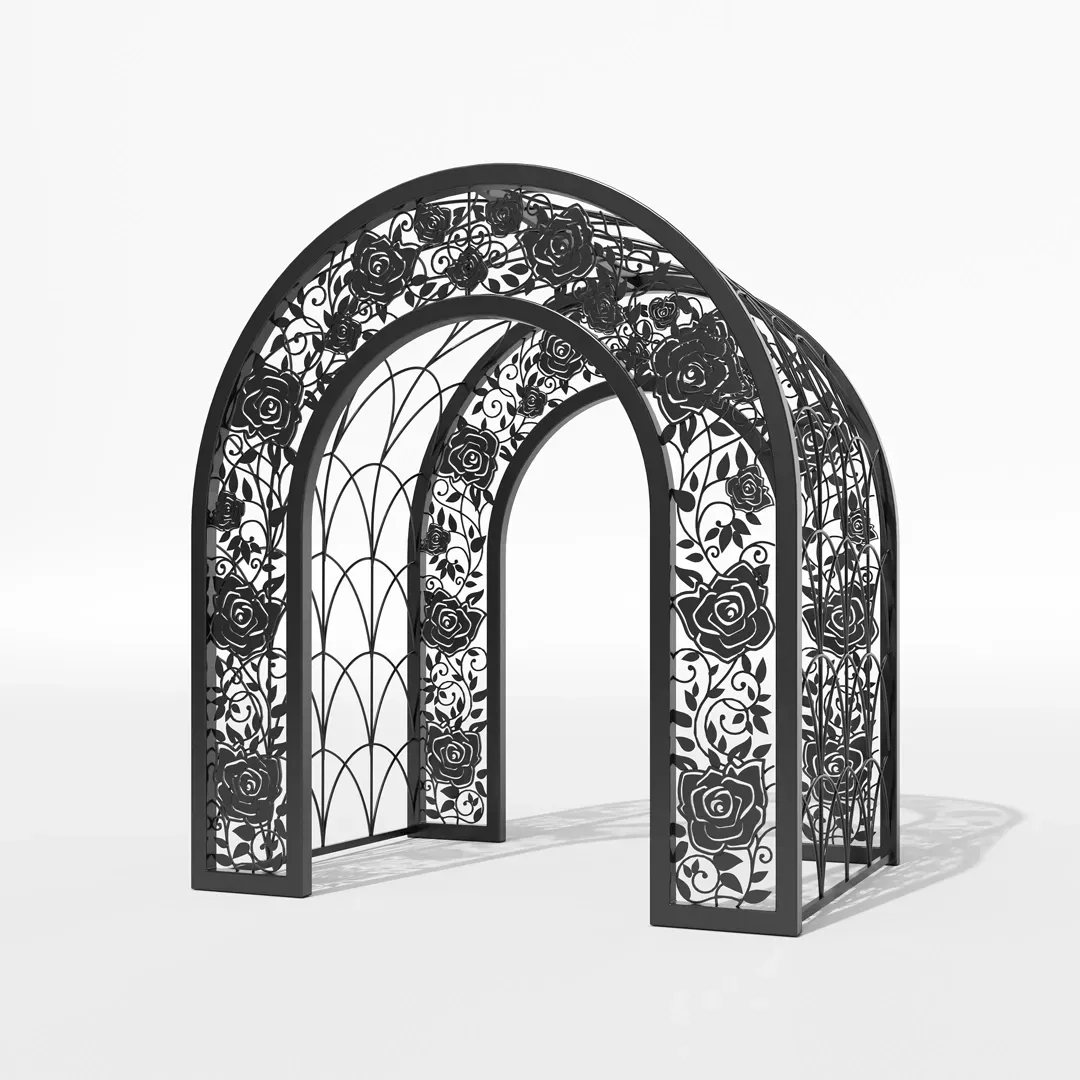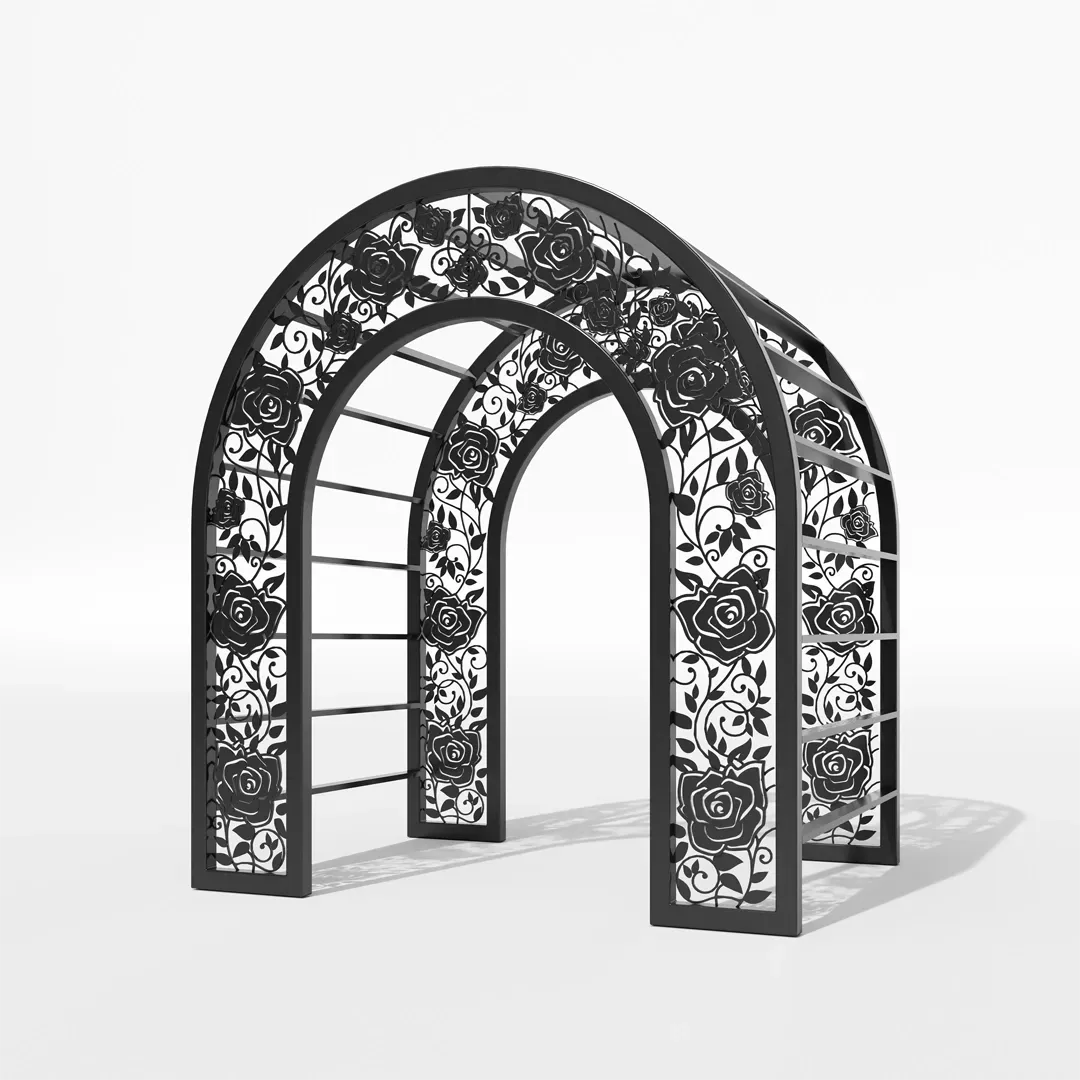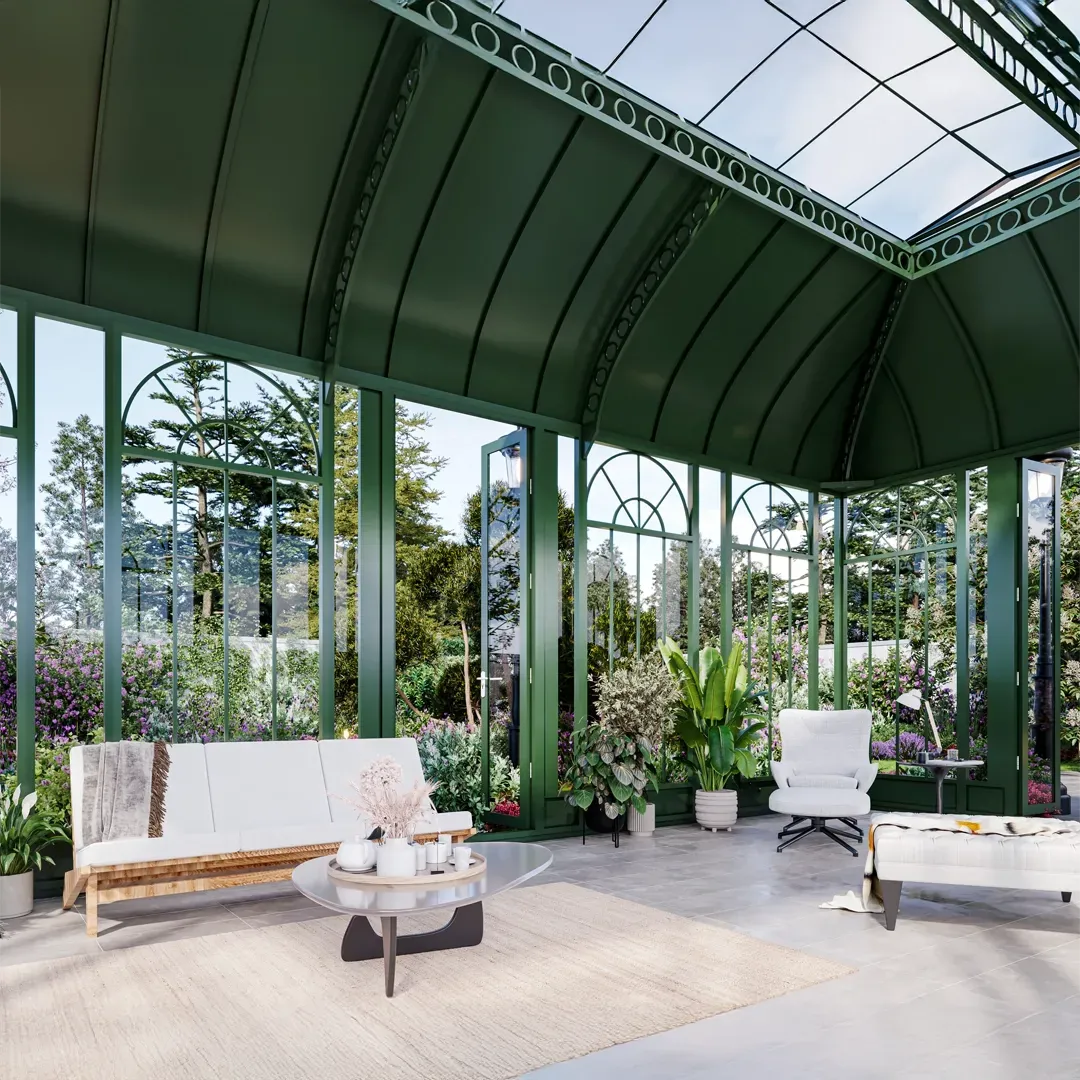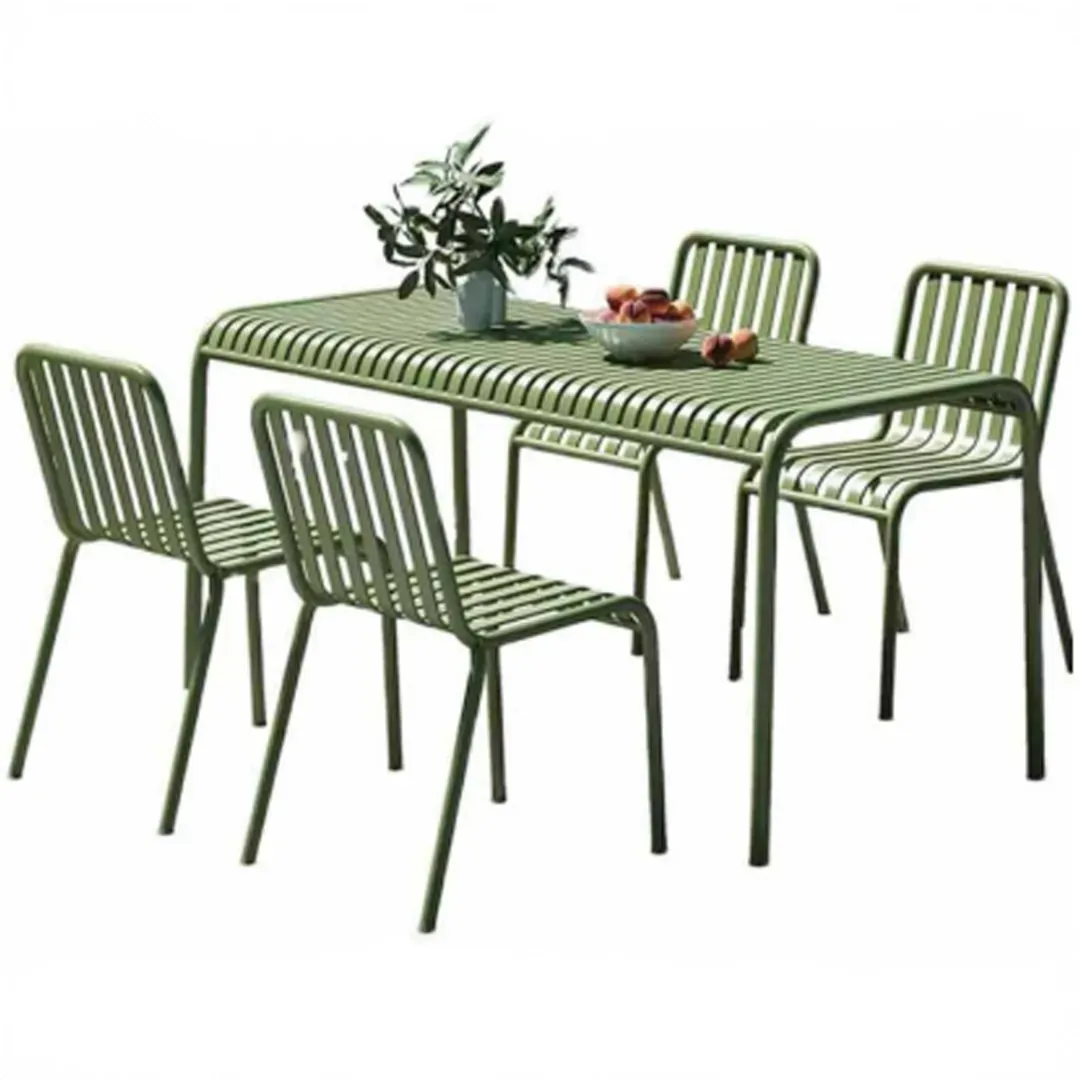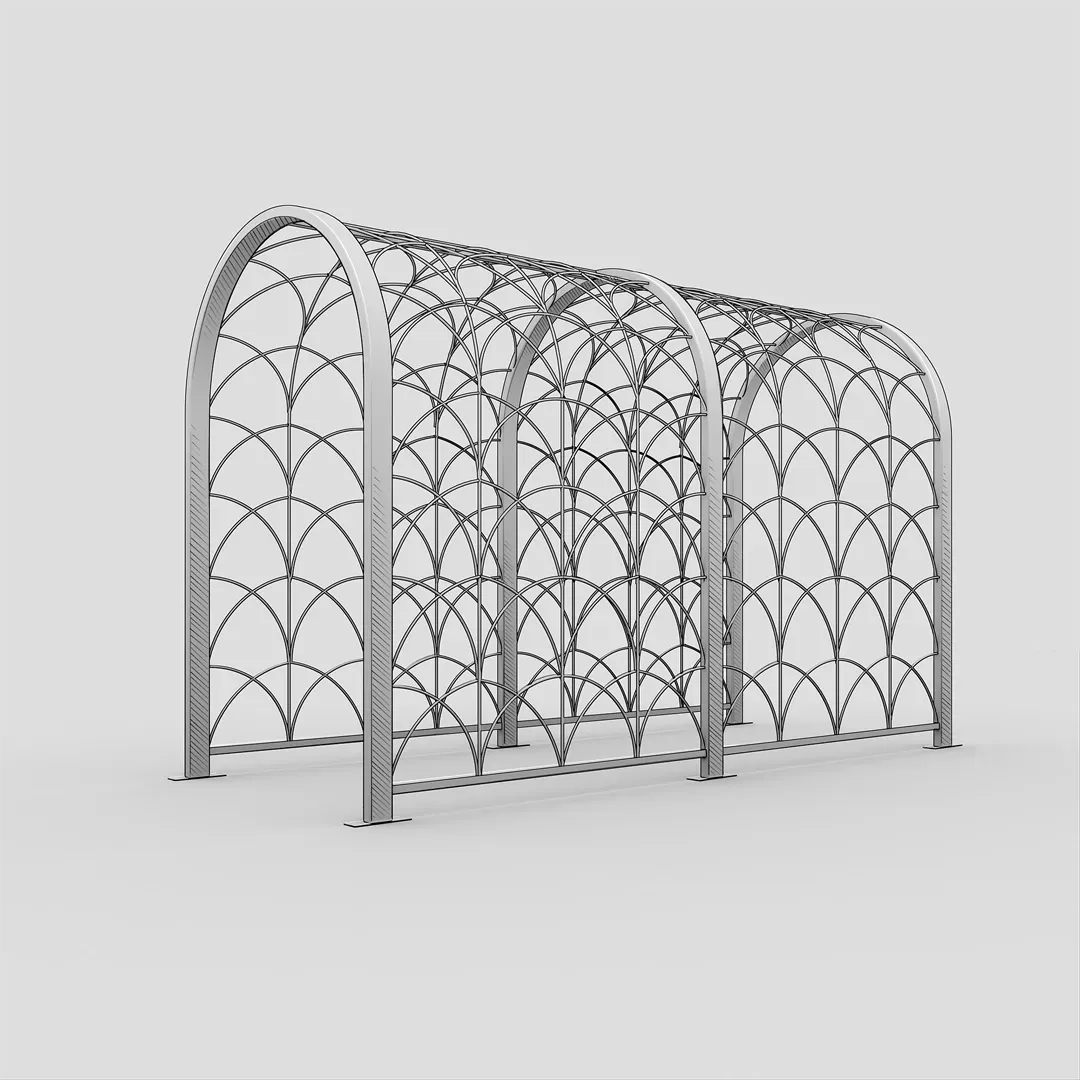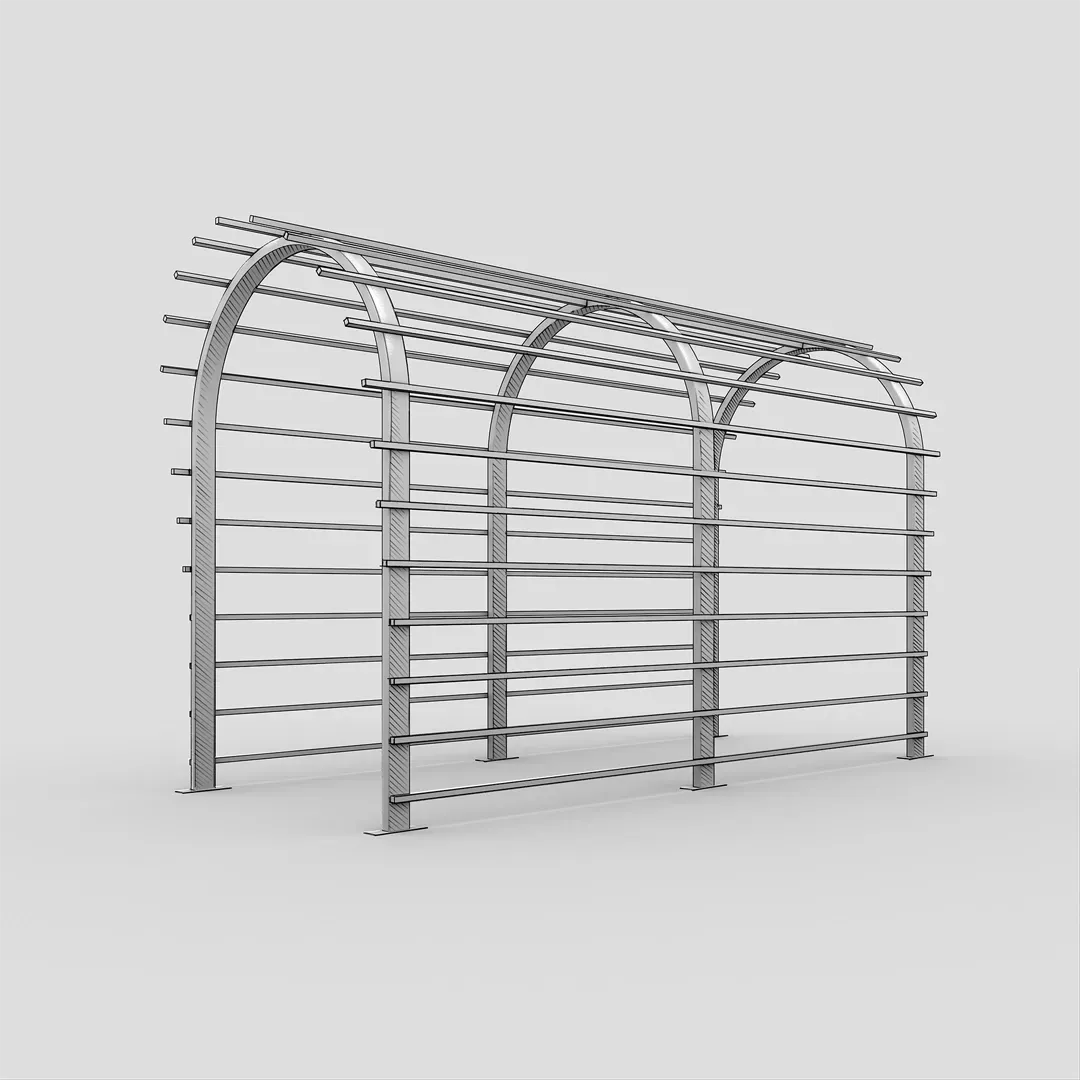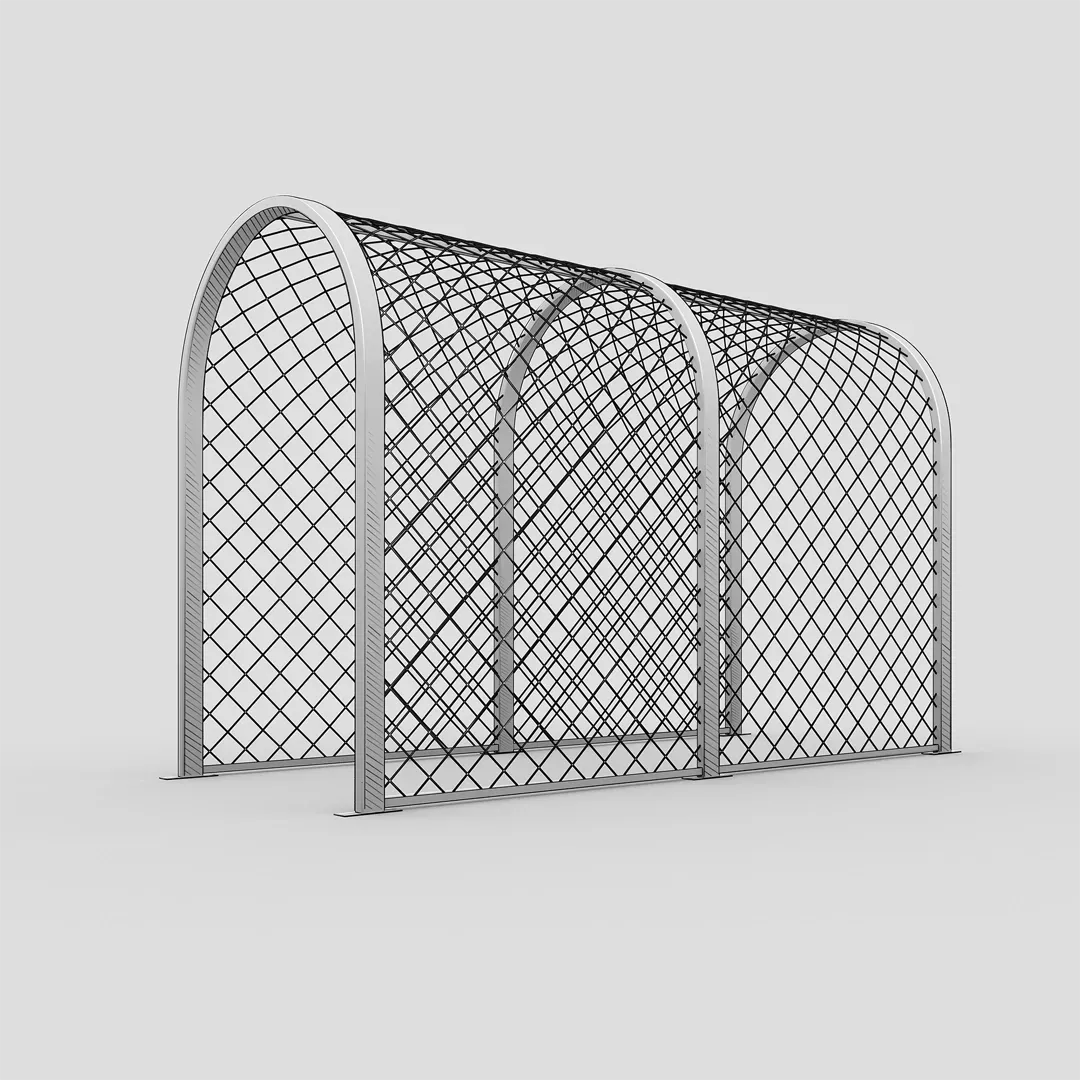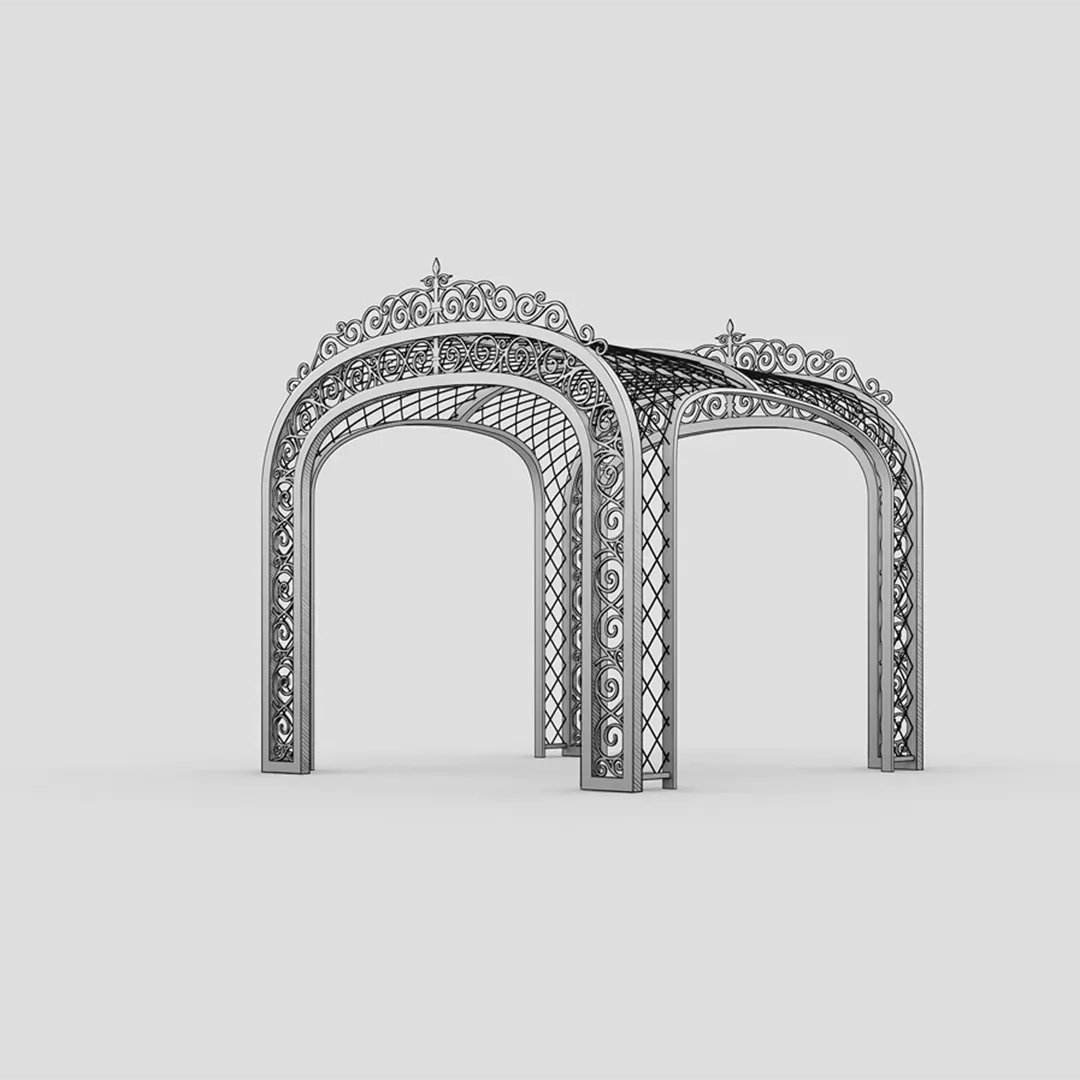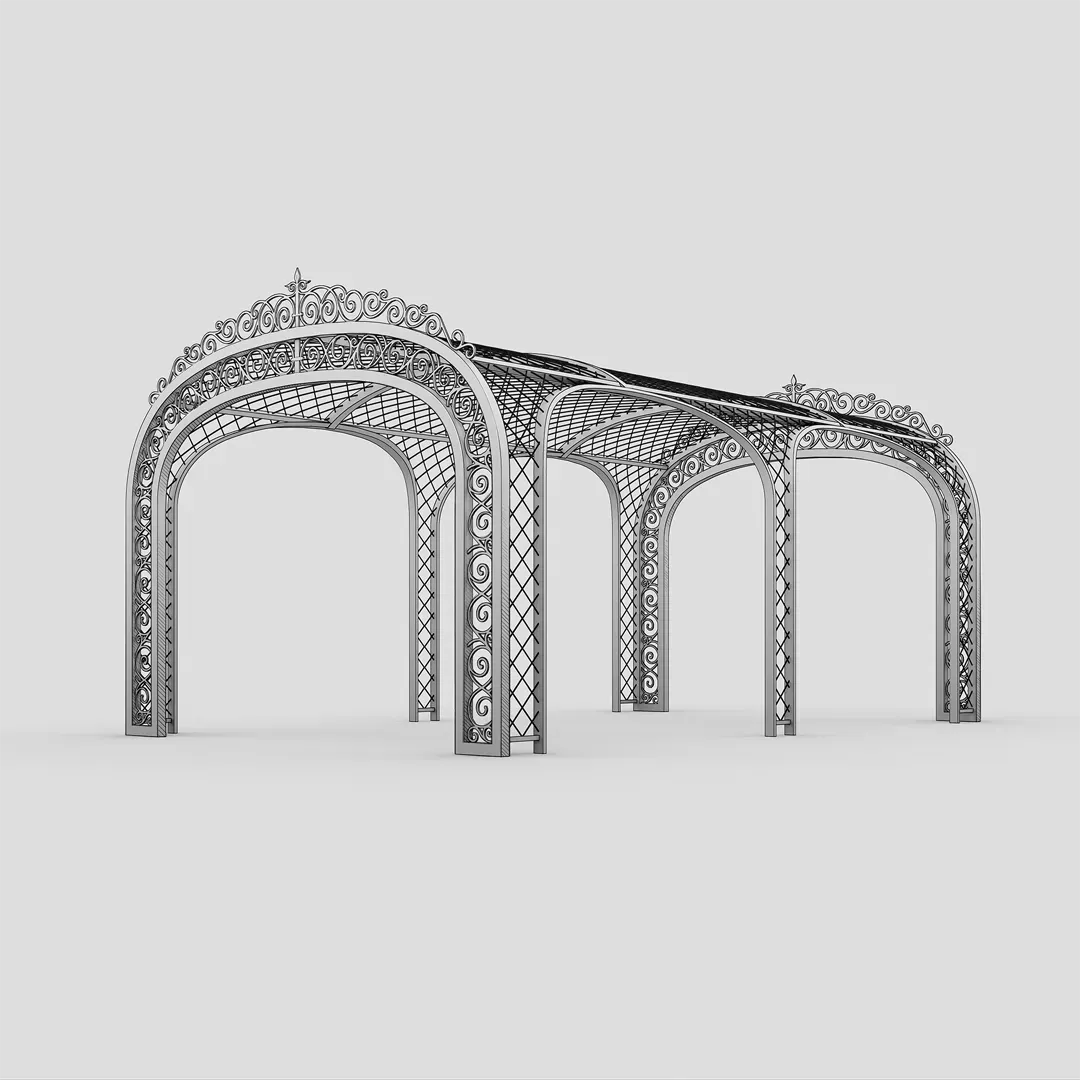Steel Gardens
Every Detail, Designed for You
At Steel Gardens, we believe your outdoor space should be as refined and beautiful as the home it complements.
We specialize in bespoke greenhouses, gazebos, garden arches, and luxury outdoor furniture collections—each piece a masterpiece of design and durability.
Materials and Craftsmanship

Sustainable Quality - That’s our philosophy.
At Steel Gardens, we believe in crafting pieces that aren’t just beautiful today—but
timeless for decades to come. Every structure we create is built from the highest-quality,
architectural-grade materials, chosen not only for their strength and performance, but for
their minimal environmental impact and unmatched longevity.
Our commitment to galvanized steel, tempered glass, and weather-resistant finishes
means our products can withstand the elements year after year, with little maintenance and
no compromise on elegance. It's a quiet rejection of disposable design—and a return to the
art of building things meant to be passed down.
When you invest in a Steel Garden structure, you’re investing in something more than a
space. You’re investing in a legacy.

Bespoke Greenhouses
Crafted with Passion, Inspired by History
Our custom-designed steel and glass greenhouses unite precision engineering, architectural artistry, and your unique vision.
Collaborate with our expert design team to craft a bespoke structure tailored to your style, space, and functional needs—where beauty meets lasting durability.
Arches & Trellis
Where Quality Stands Apart
Our arches are built to last, crafted from powder-coated structural steel that won’t rust and stands up beautifully to the elements. Available in three standard sizes, each arch is designed to integrate seamlessly into any landscape. Choose from three elegant trellis styles to elevate your garden with lasting sophistication.
Arches & Trellises
Where Quality Stands Apart
Our arches come in three standard sizes, designed to seamlessly integrate into any landscape. Choose from three distinct trellis options, each crafted to enhance your garden’s aesthetic with elegance and style.
Gazebos
A Timeless Asset in Architectural Beauty
Our gazebos are more than just shade structures—they are timeless investments in both your property and lifestyle.
Designed for entertaining, dining, or quiet relaxation, each piece is meticulously crafted to blend elegance with durability, creating a stunning focal point for your outdoor space.
Outdoor Furniture
Where Luxury Meets Lasting Strength
Elevate your outdoor space with Steel Gardens' modern, versatile furniture collection—designed to complement any garden or backyard with sophistication and comfort. Each piece is made to order, ensuring a seamless fit for your unique style and space.
Outdoor Furniture
Where Luxury Meets Lasting Strength
Elevate your outdoor space with Steel Gardens' modern, versatile furniture collection—designed to complement any garden or backyard with sophistication and comfort. Each piece is made to order, ensuring a seamless fit for your unique style and space.
Expert Advice

Top Greenhouse Heater Choices to Warm Your Winter Plants
Are you struggling with a chilly greenhouse? The right greenhouse heater can keep your plants healthy even in lower temperatures. Our comprehensive guide covers various heater options, safety protocols, and energy efficiency to help you make an informed decision without breaking the bank.
Key Takeaways:
Greenhouse heating is essential for plant growth and depends on factors such as size, insulation, climate, and efficiency of heating systems.
Proper ventilation is crucial for temperature control and safety, especially with propane heaters.
Various types of heaters are available, including electric, gas, and infrared, each suited for different greenhouse sizes and heating requirements.
Safety features and maintenance practices are important for efficiency and prevention of hazards.
Costs and energy efficiency are significant when choosing a greenhouse heater.
Understanding Greenhouse Heating Needs
Greenhouse heating is not just a matter of convenience; it's a necessity to maintain optimal growth conditions for plants, especially during the colder months. The warmth inside a greenhouse depends on the covering materials' ability to trap solar heat and re-radiate it within the environment.
Several factors influence the heating needs of a greenhouse:
Size of the space
Level of insulation
Regional climate
Safety features and energy efficiency of potential heating systems
Heat loss mechanisms (convection, conduction, and radiation)
Considering these factors will help determine the most effective heating solution for your greenhouse. Ultimately, choosing the right heater involves a deep understanding of your greenhouse's specific heating needs, considering factors like its square footage, temperature requirements, and heat loss factors.
Proper Ventilation
Ventilation is an often-overlooked aspect of greenhouse heating. A well-ventilated greenhouse maintains optimal temperatures and prevents frost damage, ensuring that your plants receive just the right amount of heat they need to thrive. This is achieved by promoting the exchange of warm internal air with cooler external air, preventing overheating and ensuring a consistent temperature for your plants.
Methods to achieve proper ventilation include:
Natural ventilation using vents for small greenhouses
Engineered ventilation systems with exhaust fans and motorized louvers for larger greenhouses
Adequate ventilation for greenhouses using propane heaters to avoid carbon monoxide buildup
Cold Weather Challenges
Cold weather presents unique challenges for greenhouse heating. The key is to maintain a consistent temperature, which is crucial for plant survival and healthy growth. This means that even as the mercury dips outside, your greenhouse should remain a warm haven for your plants.
Types of Greenhouse Heaters
Greenhouse heaters come in various types, each with its unique set of advantages and drawbacks. The different types include:
Steam systems
Hot water systems
Hot air systems
Infrared systems
Fuel options add another layer of complexity to the decision-making process. You can choose from natural gas, LP gas, fuel oil, wood, or electricity, depending on availability and cost-effectiveness in your location.
Electric Heaters
Electric heaters are often regarded as the safest options for greenhouses, thanks to their built-in safety features. These heaters come with safety measures designed to prevent overheating, which is a common concern in greenhouse environments.
One excellent option for small to medium-sized greenhouses is the JNDRO Portable Electric Space Heater. This 1500W/750W ceramic heater features dual heat settings, thermostat control, and safety features like overheat protection and tip-over protection. It's compact, portable, and can heat up to 200 square feet, making it ideal for smaller greenhouses or targeted heating in larger spaces.
For those seeking a smart heating solution, the Govee Electric Space Heater offers 1500W of power with Wi-Fi and Bluetooth app control. It's compatible with Alexa and Google Assistant, allowing for voice control of your greenhouse temperature. The PTC ceramic heating technology ensures rapid warmth distribution, while safety features like tip-over and over-heating protection provide peace of mind.
Gas and Propane Heaters
Gas heaters, such as those using natural and bottled gas, are renowned for their economic and efficient heating capabilities, especially in colder climates. Propane heaters offer substantial warmth and are cost-effective, although they need proper ventilation to avoid carbon monoxide issues.
Modern greenhouse gas heaters are often equipped with multiple safety devices, including thermocouples and Oxygen Depletion Systems (ODS), to ensure safety. When installing a gas heater, it's important to follow the instructions carefully and conduct a soapy water test to check for leaks.
Infrared and Paraffin Heaters
Infrared heaters provide targeted radiant heat, warming plants and objects directly without heating the air first. This makes them particularly energy efficient for smaller spaces. However, they might not provide adequate warmth under extremely cold conditions.
For those looking for a versatile heating solution, the Dreo Space Heater combines PTC ceramic heating technology with infrared elements. It offers precise temperature control from 41-95°F, multiple modes including Power Heat and Eco, and operates quietly at just 34dB. Its portable design with a handle makes it easy to move around your greenhouse as needed.
Best Greenhouse Heater Recommendations for Different Spaces
Choosing the right greenhouse heater depends on the size of your greenhouse, the type of plants you're growing, and your specific heating needs. Here are some recommendations for different greenhouse sizes:
Small Greenhouses
For small greenhouses, electric fan heaters, oil-filled radiators, and heat mats are excellent choices. The JNDRO Portable Electric Space Heater mentioned earlier is a great option, heating areas up to 160 square feet with an adjustable thermostat and fan for better air circulation.
For targeted warmth and energy efficiency, consider the BN-LINK Seedling Heat Mat. This 10" x 20.75" waterproof heating pad provides consistent, uniform heating ideal for seed starting and cutting propagation. It's easy to clean, durable, and comes with a 15-month warranty.
Medium-sized Greenhouses
For medium-sized greenhouses, the Dreo Space Heater is a suitable choice. Its 1500W output and precise temperature control make it efficient for larger spaces, while its multiple modes allow for customized heating based on your greenhouse's needs.
Large Greenhouses
Large greenhouses require powerful heating options. The Bio Green PAL 2.0/USDT Palma Greenhouse Heater is designed for efficient heating in spaces up to 130 ft². It features two adjustable heating elements (750W or 1500W), precise thermostat control from -58°F to 210.2°F, and an air circulation mode to prevent mold buildup. Its durable stainless steel housing and foldable carrying handle make it both robust and portable.
Greenhouse Heater Safety and Maintenance
Safety and maintenance are crucial when it comes to greenhouse heaters. Here are some important considerations:
Safety Features
Essential safety features include:
Overheat protection to reduce the risk of fire
Certification by recognized agencies for safety standards
Tip-over protection (found in heaters like the JNDRO Portable Electric Space Heater)
Flame-resistant materials
Installation Tips
Proper installation of greenhouse heaters is crucial for their safe and efficient operation. For electric heaters, install a dedicated electricity supply with individually RCD-protected sockets. Maintain adequate clearance from combustible materials to reduce fire risks.
For propane heaters, consistently monitor gas levels in propane canisters to prevent sudden run-outs. You can use the 'hot water trick' to estimate the remaining gas.
Maintenance Practices
Regular maintenance can lead to fuel savings and more uniform heat distribution. Here are some key maintenance practices:
Annual maintenance by a skilled technician
Regular cleaning and adjustment of greenhouse furnaces and boilers
Replacing air filters and cleaning fan blades to maintain maximum airflow
Periodically checking combustion efficiency
Conducting an energy audit using tools like the USDA Energy Self-Assessment
Cost and Energy Efficiency Considerations
When choosing a greenhouse heater, consider both initial costs and long-term energy efficiency. Electric heaters like the JNDRO Portable Electric Space Heater and Govee Electric Space Heater are generally less expensive to install but may have higher operating costs for prolonged use.
Gas heaters can be more expensive upfront but offer higher BTU output, potentially translating to better cost-effectiveness for larger spaces in the long run.
Energy Efficiency
Energy efficiency varies by heater type:
Propane or natural gas heaters: around 78% efficiency
Heating oil heaters: approximately 75% efficiency
Cord wood stoves: vary from 20% to 75% depending on the model
Smart heaters like the Govee Electric Space Heater offer additional energy-saving features through app control and scheduling.
Saving Money on Heating
To save on heating costs:
Insulate distribution pipes in unheated or underground areas
Seal air leaks
Use energy-conserving screens (can save 20% to 50% on heating bills)
Consider alternative fuels like biomass boilers or solar energy
Compartmentalize germination and production areas
For precise temperature control and energy savings, consider using a thermostat controller like the BN-LINK Digital Heat Mat Thermostat Controller. It's versatile enough for seed germination, reptile habitats, and brewing setups, allowing you to maintain optimal temperatures without wasting energy.
Summary
Choosing the right greenhouse heater is crucial for maintaining optimal growing conditions for your plants year-round. From understanding your specific heating needs to selecting the appropriate heater type and size, there are many factors to consider. Remember to prioritize safety features, regular maintenance, and energy efficiency to ensure the best results for your greenhouse and your wallet.
Whether you opt for a portable electric heater like the JNDRO Portable Electric Space Heater, a smart solution like the Govee Electric Space Heater, or a powerful greenhouse-specific heater like the Bio Green PAL 2.0/USDT Palma Greenhouse Heater, the goal is to create a warm haven where your plants can thrive all year round.
Don't forget to complement your heating system with useful accessories like the BN-LINK Seedling Heat Mat for targeted warmth and the BN-LINK Digital Heat Mat Thermostat Controller for precise temperature management. With the right equipment and knowledge, you can turn your greenhouse into a flourishing oasis, regardless of the weather outside.
Frequently Asked Questions
What factors influence greenhouse heating needs?
The size of the greenhouse, its insulation, regional climate, and the safety features and energy efficiency of heating systems all affect the greenhouse heating needs. Consider these factors when planning for heating. For instance, a larger greenhouse like one suitable for the Bio Green PAL 2.0/USDT Palma Greenhouse Heater will have different heating requirements compared to a small hobby greenhouse that might be adequately served by the JNDRO Portable Electric Space Heater.
What are the different types of greenhouse heaters?
Greenhouse heaters come in various types, including electric, gas, propane, and infrared, each with its unique set of advantages and drawbacks. Electric heaters like the Govee Electric Space Heater offer smart features and easy installation, while gas heaters might be more cost-effective for larger spaces. It's important to choose the type that best suits your specific greenhouse needs.
How important is ventilation in a greenhouse?
Ventilation is crucial in a greenhouse as it helps maintain optimal temperatures and prevents frost damage. Good ventilation also reduces the risk of disease and pest infestations. When using heaters, especially in enclosed spaces, proper ventilation becomes even more critical to ensure air circulation and prevent the buildup of harmful gases.
Are there specific heater recommendations for different sized greenhouses?
Yes, heater recommendations vary based on greenhouse size:
For small greenhouses, electric fan heaters like the JNDRO Portable Electric Space Heater or heat mats like the BN-LINK Seedling Heat Mat work well.
Medium-sized greenhouses might benefit from more powerful electric heaters like the Dreo Space Heater.
Larger greenhouses may require more robust solutions like the Bio Green PAL 2.0/USDT Palma Greenhouse Heater or natural gas heaters.
How can I save money on heating my greenhouse?
To save money on heating your greenhouse:
Insulate it properly to retain heat.
Seal air leaks to prevent heat loss.
Use energy-conserving screens to trap heat at night.
Consider alternative fuels or solar energy for long-term savings.
Use a smart thermostat controller like the BN-LINK Digital Heat Mat Thermostat Controller to maintain optimal temperatures without wasting energy.
Implement zone heating to focus warmth where it's most needed.
These strategies will help you reduce heating costs and make your greenhouse more energy-efficient.
What safety features should I look for in a greenhouse heater?
When choosing a greenhouse heater, look for the following safety features:
Overheat protection: This automatically shuts off the heater if it gets too hot, preventing fire hazards.
Tip-over protection: Found in heaters like the JNDRO Portable Electric Space Heater, this feature turns off the heater if it's knocked over.
Flame-resistant materials: These reduce the risk of fire spreading if an issue occurs.
Oxygen depletion sensors: Particularly important for gas heaters, these shut off the heater if oxygen levels drop too low.
ETL or UL certification: These indicate the heater has been tested for safety standards.
How do I maintain my greenhouse heater for optimal performance?
To maintain your greenhouse heater:
Clean it regularly to remove dust and debris.
Check and replace filters as needed.
Inspect wiring and connections for any signs of wear or damage.
For gas heaters, have them professionally serviced annually.
Keep the area around the heater clear of plants and flammable materials.
Regularly check that safety features are functioning correctly.
Use a thermostat controller like the BN-LINK Digital Heat Mat Thermostat Controller to ensure consistent, efficient operation.
Can I use a regular space heater in my greenhouse?
While it's possible to use a regular space heater in a greenhouse, it's generally not recommended for several reasons:
Most regular space heaters aren't designed for the high humidity environment of a greenhouse.
They may not have the necessary safety features for greenhouse use.
Regular space heaters might not distribute heat evenly enough for optimal plant growth.
Instead, opt for heaters designed specifically for greenhouse use or those with features suitable for greenhouse environments. For instance, the Govee Electric Space Heater offers smart controls and safety features that make it more suitable for greenhouse use than a standard space heater.
How do I determine the right size heater for my greenhouse?
To determine the right size heater for your greenhouse:
Calculate the volume of your greenhouse in cubic feet.
Determine the desired temperature difference between inside and outside.
Consider the materials your greenhouse is made from (glass, plastic, etc.) as this affects heat retention.
Factor in your local climate and typical winter temperatures.
As a general rule, you'll need about 0.6 to 1 watt per cubic foot of greenhouse space to raise the temperature by 10°F. However, it's often better to choose a slightly oversized heater to ensure adequate warmth during the coldest periods.
What's the difference between convection and radiant heating for greenhouses?
Convection heating warms the air in the greenhouse, which then circulates to warm the plants. Electric fan heaters like the JNDRO Portable Electric Space Heater typically use convection heating.
Radiant heating, on the other hand, directly warms objects and surfaces in its path without necessarily heating the air. Infrared heaters and heat mats like the BN-LINK Seedling Heat Mat use radiant heating.
Both methods have their place in greenhouse heating. Convection heating is good for maintaining overall air temperature, while radiant heating can be more energy-efficient for targeted plant warming.
Conclusion
Choosing the right greenhouse heater is a crucial step in creating an optimal environment for your plants to thrive year-round. By understanding your specific heating needs, considering factors like greenhouse size, local climate, and energy efficiency, and selecting appropriate heating solutions, you can ensure your greenhouse remains a warm, nurturing space even in the coldest months.
Remember, the best greenhouse heating solution often combines different types of heaters and accessories. For instance, you might use a powerful heater like the Bio Green PAL 2.0/USDT Palma Greenhouse Heater for overall heating, supplement it with heat mats like the BN-LINK Seedling Heat Mat for seedlings and temperature-sensitive plants, and control it all with a smart thermostat like the BN-LINK Digital Heat Mat Thermostat Controller.
Don't forget to prioritize safety features, regular maintenance, and energy efficiency in your heating setup. With the right equipment and knowledge, you can create a flourishing greenhouse oasis that defies the winter chill and keeps your plants happy and healthy all year long.
The Material Difference
Precision in Strength, Perfection in Detail
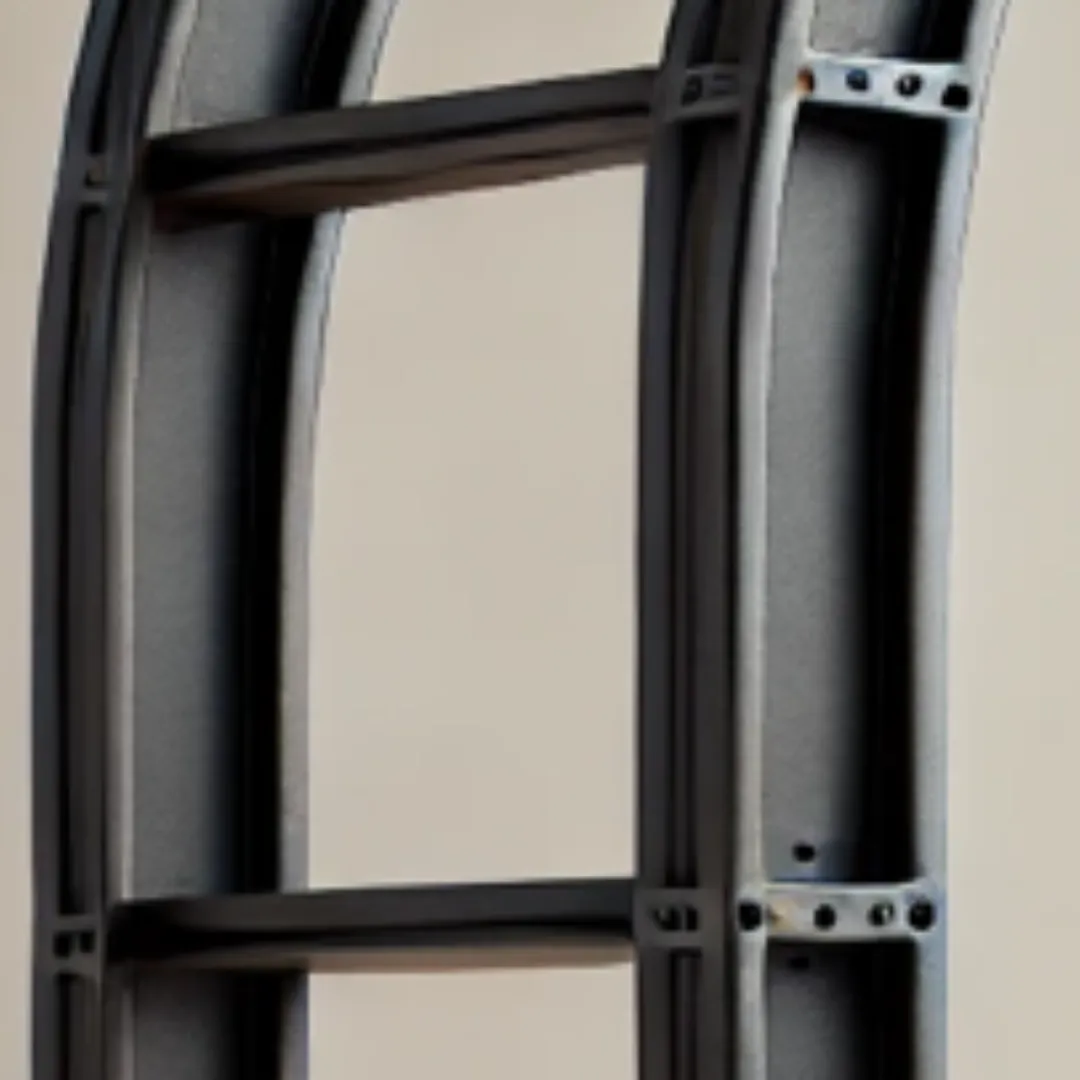
Our Structural Steel:
Engineered to exceed stringent industry standards, our structural steel is built for construction and engineering projects where strength, stability, and load-bearing capacity are paramount. Designed to withstand significant stress without bending or breaking, it ensures lasting durability and reliability.
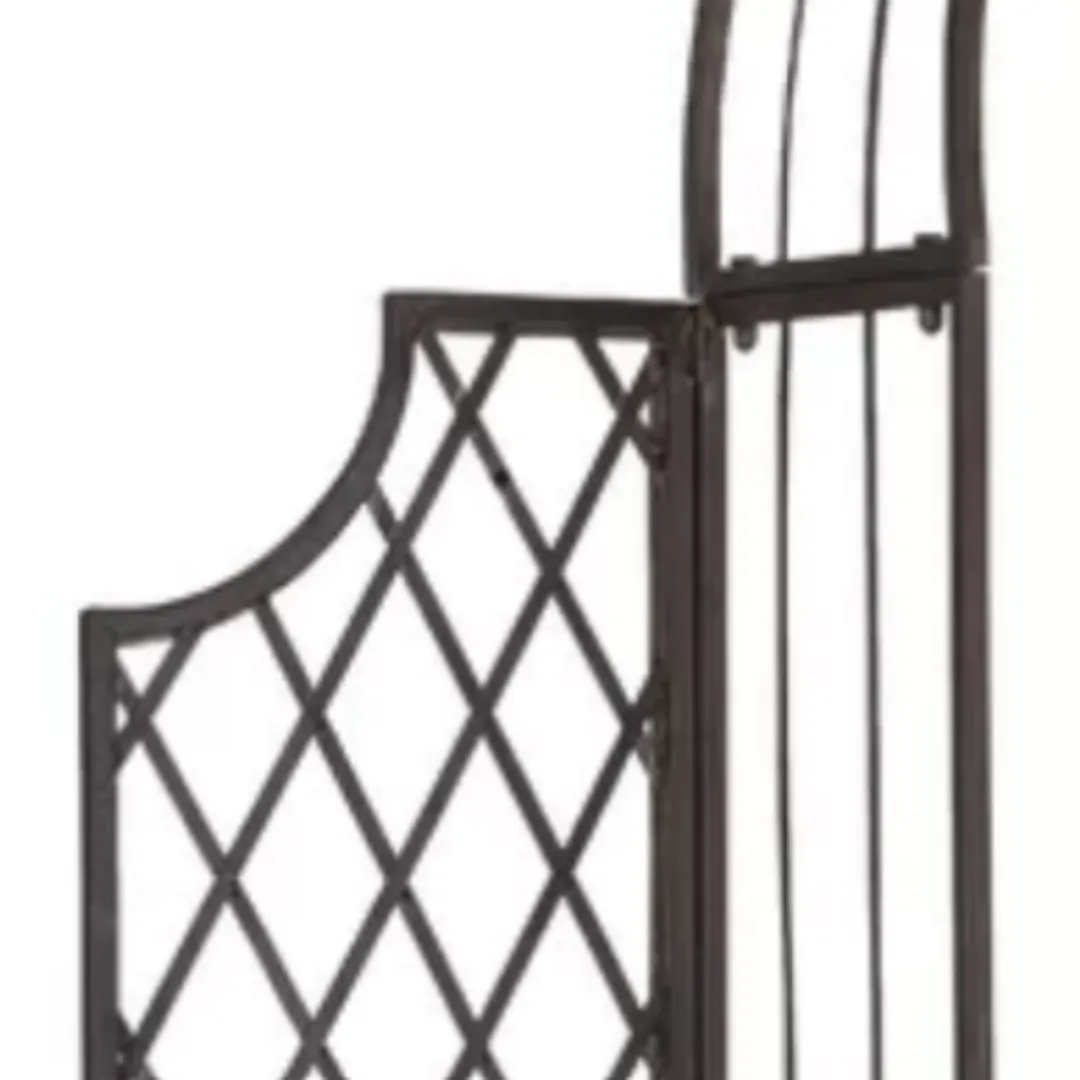
Other Brands:
Many competitors use thin, low-grade steel or lightweight metals like aluminum, which lack the resilience and strength needed to support heavy loads or endure harsh weather conditions.
Real Clients, Real Customization
Common Questions
What Makes Our Greenhouses Unique?
At Steel Gardens, our greenhouses are crafted with premium materials, including reinforced glass, and feature exquisite designs with unparalleled customization options. Built for unmatched durability, aesthetics, and functionality, they are perfect for avid gardeners and so much more. Whether you use your greenhouse for gardening, as an elegant entertaining space, a creative studio, or a tranquil retreat, each design combines beauty and versatility to enhance your lifestyle and property.
What maintenance is required for an Steel Gardens greenhouse and how do I ensure optimal performance?
Alpine Greenhouses are incredibly low maintenance. Our programmable exhaust fans allow you to specify temperature and humidity settings, allowing for automated control of your environment. With the benefit of a steel roof, cleaning as needed of your glass glazing is all that is regularly needed to enjoy this stunning addition to your property.
Can I customize the design and size of my greenhouse?
Yes, our greenhouses are fully customizable to suit your unique vision and requirements. Our design team works closely with you to assess your personal intentions for use, whether it’s gardening, entertaining, or creating a relaxing retreat. We also take into account your color preferences, size needs, and property specifications to ensure the greenhouse integrates seamlessly with your outdoor space. With a wide range of sizes, styles, materials, and finishes available, we help you create a bespoke greenhouse that not only complements your property but also fulfills your lifestyle goals.
What are the standard installation costs for a custom greenhouse?
The installation and site preparation costs for a custom greenhouse typically align with the model's material costs. These expenses reflect the skilled labor and precision required to properly assemble the structure, integrate custom features, and meet local code requirements. Site preparation—such as leveling, foundation work, and drainage—can also influence the overall cost based on the property’s specific needs and design requirements.
What factors should I consider when planning and designing a custom greenhouse?
Design with confidence - Get Our Greenhouse Guide
Designing a custom greenhouse is an exciting opportunity to create a functional and beautiful space tailored to your needs. Here are some important considerations to keep in mind:
What is your primary goal?
Will your greenhouse be used for gardening, entertaining, relaxation, or as a multi-purpose space? Understanding your intentions will guide key design decisions, such as size, layout, and features.
Where will the greenhouse be placed?
Choose a location that maximizes sunlight exposure, typically a south-facing position. Consider factors like wind exposure, drainage, and accessibility.
How does it fit into your landscape?
Ensure the greenhouse complements the style and layout of your property for seamless integration.
What size works best for your needs?
The greenhouse should be large enough for its intended purpose but proportionate to your property. Consider future uses to avoid outgrowing the space.
What aesthetic appeals to you?
Choose a design style that complements your home and personal taste, whether it’s modern, Victorian, Colonial, or something else.
Customization options:
Explore options like decorative ironwork, custom colors, roof profiles, or unique window designs to make your greenhouse one-of-a-kind.
What type of glazing is ideal?
Options include single-pane tempered glass for aesthetics or double-pane glass with Low-E coatings for improved insulation and energy efficiency.
Thermal performance:
Consider insulated foundations or climate battery systems for year-round temperature regulation.
How will you maintain optimal growing conditions?
Incorporate features like heating, cooling, ventilation, and humidity control to create the ideal environment for plants and people.
What foundation will support your greenhouse?
Options range from simple ground screws to advanced insulated foundations, depending on thermal needs and site conditions. Ensure proper drainage to prevent water issues.
What materials best suit your needs?
High-quality materials like aluminum, steel, and reinforced glass ensure longevity and low maintenance.
Do you need electricity?
Plan for lighting, fans, and other electrical components to enhance usability, especially for evening use or winter gardening.
How Do Our Greenhouses Manage Climate Control?
We believe greenhouses should be optimized for many uses, not simply high production gardening. In comparison to glass or polycarbonate roofed greenhouses which can be far too hot to enjoy, our models significantly reduce heat gain while still providing an ample amount of sunlight for your gardening interests. Maintaining consistent temperature controls is a priority for those interested in creating an environment comfortable for any number of activities.
How can my greenhouse provide a valuable return on investment?
We believe greenhouses should be optimized for many uses, not simply high production gardening. In comparison to glass or polycarbonate roofed greenhouses which can be far too hot to enjoy, our models significantly reduce heat gain while still providing an ample amount of sunlight for your gardening interests. Maintaining consistent temperature controls is a priority for those interested in creating an environment comfortable for any number of activities.
How does Steel Gardens assist with permits?
We believe greenhouses should be optimized for many uses, not simply high production gardening. In comparison to glass or polycarbonate roofed greenhouses which can be far too hot to enjoy, our models significantly reduce heat gain while still providing an ample amount of sunlight for your gardening interests. Maintaining consistent temperature controls is a priority for those interested in creating an environment comfortable for any number of activities.
What is the Lowest Maintenance Roof Option?
We believe greenhouses should be optimized for many uses, not simply high production gardening. In comparison to glass or polycarbonate roofed greenhouses which can be far too hot to enjoy, our models significantly reduce heat gain while still providing an ample amount of sunlight for your gardening interests. Maintaining consistent temperature controls is a priority for those interested in creating an environment comfortable for any number of activities.
What type of Foundations do we recommend?
We believe greenhouses should be optimized for many uses, not simply high production gardening. In comparison to glass or polycarbonate roofed greenhouses which can be far too hot to enjoy, our models significantly reduce heat gain while still providing an ample amount of sunlight for your gardening interests. Maintaining consistent temperature controls is a priority for those interested in creating an environment comfortable for any number of activities.
Common Questions
What Makes Our Greenhouses Unique?
At Steel Gardens, our greenhouses are crafted with premium materials, including reinforced glass, and feature exquisite designs with unparalleled customization options. Built for unmatched durability, aesthetics, and functionality, they are perfect for avid gardeners and so much more. Whether you use your greenhouse for gardening, as an elegant entertaining space, a creative studio, or a tranquil retreat, each design combines beauty and versatility to enhance your lifestyle and property.
What maintenance is required for an Steel Gardens greenhouse and how do I ensure optimal performance?
Alpine Greenhouses are incredibly low maintenance. Our programmable exhaust fans allow you to specify temperature and humidity settings, allowing for automated control of your environment. With the benefit of a steel roof, cleaning as needed of your glass glazing is all that is regularly needed to enjoy this stunning addition to your property.
Can I customize the design and size of my greenhouse?
Yes, our greenhouses are fully customizable to suit your unique vision and requirements. Our design team works closely with you to assess your personal intentions for use, whether it’s gardening, entertaining, or creating a relaxing retreat. We also take into account your color preferences, size needs, and property specifications to ensure the greenhouse integrates seamlessly with your outdoor space. With a wide range of sizes, styles, materials, and finishes available, we help you create a bespoke greenhouse that not only complements your property but also fulfills your lifestyle goals.
What are the standard installation costs for a custom greenhouse?
The installation and site preparation costs for a custom greenhouse typically align with the model's material costs. These expenses reflect the skilled labor and precision required to properly assemble the structure, integrate custom features, and meet local code requirements. Site preparation—such as leveling, foundation work, and drainage—can also influence the overall cost based on the property’s specific needs and design requirements.
What factors should I consider when planning and designing a custom greenhouse?
Design with confidence - Get Our Greenhouse Planning Guide
Designing a custom greenhouse is an exciting opportunity to create a functional and beautiful space tailored to your needs. Here are some important considerations to keep in mind:
What is your primary goal?
Will your greenhouse be used for gardening, entertaining, relaxation, or as a multi-purpose space? Understanding your intentions will guide key design decisions, such as size, layout, and features.
Where will the greenhouse be placed?
Choose a location that maximizes sunlight exposure, typically a south-facing position. Consider factors like wind exposure, drainage, and accessibility.
How does it fit into your landscape?
Ensure the greenhouse complements the style and layout of your property for seamless integration.
What size works best for your needs?
The greenhouse should be large enough for its intended purpose but proportionate to your property. Consider future uses to avoid outgrowing the space.
What aesthetic appeals to you?
Choose a design style that complements your home and personal taste, whether it’s modern, Victorian, Colonial, or something else.
Customization options:
Explore options like decorative ironwork, custom colors, roof profiles, or unique window designs to make your greenhouse one-of-a-kind.
What type of glazing is ideal?
Options include single-pane tempered glass for aesthetics or double-pane glass with Low-E coatings for improved insulation and energy efficiency.
Thermal performance:
Consider insulated foundations or climate battery systems for year-round temperature regulation.
How will you maintain optimal growing conditions?
Incorporate features like heating, cooling, ventilation, and humidity control to create the ideal environment for plants and people.
What foundation will support your greenhouse?
Options range from simple ground screws to advanced insulated foundations, depending on thermal needs and site conditions. Ensure proper drainage to prevent water issues.
What materials best suit your needs?
High-quality materials like aluminum, steel, and reinforced glass ensure longevity and low maintenance.
Do you need electricity?
Plan for lighting, fans, and other electrical components to enhance usability, especially for evening use or winter gardening.
How Do Our Greenhouses Manage Climate Control?
We believe greenhouses should be optimized for many uses, not simply high production gardening. In comparison to glass or polycarbonate roofed greenhouses which can be far too hot to enjoy, our models significantly reduce heat gain while still providing an ample amount of sunlight for your gardening interests. Maintaining consistent temperature controls is a priority for those interested in creating an environment comfortable for any number of activities.
How can my greenhouse provide a valuable return on investment?
We believe greenhouses should be optimized for many uses, not simply high production gardening. In comparison to glass or polycarbonate roofed greenhouses which can be far too hot to enjoy, our models significantly reduce heat gain while still providing an ample amount of sunlight for your gardening interests. Maintaining consistent temperature controls is a priority for those interested in creating an environment comfortable for any number of activities.
How does Steel Gardens assist with permits?
We believe greenhouses should be optimized for many uses, not simply high production gardening. In comparison to glass or polycarbonate roofed greenhouses which can be far too hot to enjoy, our models significantly reduce heat gain while still providing an ample amount of sunlight for your gardening interests. Maintaining consistent temperature controls is a priority for those interested in creating an environment comfortable for any number of activities.
What is the Lowest Maintenance Roof Option?
We believe greenhouses should be optimized for many uses, not simply high production gardening. In comparison to glass or polycarbonate roofed greenhouses which can be far too hot to enjoy, our models significantly reduce heat gain while still providing an ample amount of sunlight for your gardening interests. Maintaining consistent temperature controls is a priority for those interested in creating an environment comfortable for any number of activities.
What type of Foundations do we recommend?
We believe greenhouses should be optimized for many uses, not simply high production gardening. In comparison to glass or polycarbonate roofed greenhouses which can be far too hot to enjoy, our models significantly reduce heat gain while still providing an ample amount of sunlight for your gardening interests. Maintaining consistent temperature controls is a priority for those interested in creating an environment comfortable for any number of activities.
Contact
Email Us
Schedule a Call with a Designer
Request a Personalized Quote
Stay Inspired. Stay Informed...
Be the first to experience our latest collections and design inspirations. Subscribe now and step into a world of refined living.
© COPYRIGHT 2025 • All Rights Reserved • Privacy Policy • Terms of Use
Digital Design and Management: Ally Digital
© COPYRIGHT 2025 • All Rights Reserved
Privacy Policy • Terms of Use
Digital Design and Management: Ally Digital

